A longish sum post this time mates, so go to shop to bring a beer while the page loads a load of photos 
Route:
<iframe width='600' height='480px' scrolling='no' frameborder='0' src='http://www.geoape.com/embeded/yhelteljelee-indoneesia-1593'></iframe>
We spotted a Hindu funeral while in Bali:
<object width="560" height="340"><param name="movie" value="http://www.youtube.com/v/JUjRYwpCLBA&hl=en_US&fs=1&"></param><param name="allowFullScreen" value="true"></param><param name="allowscriptaccess" value="always"></param><embed src="http://www.youtube.com/v/JUjRYwpCLBA&hl=en_US&fs=1&" type="application/x-shockwave-flash" allowscriptaccess="always" allowfullscreen="true" width="560" height="340"></embed></object>
They do it in a VERY different way compared to the western people who mourn, cry, sad faces, sad music, etc etc...
For Hindus death is just a path of endless life cycle. Soul leaves your body, your body will be given to space and your soul will reincarnate. But for Hindus it is VERY important that the soul doesn't find its way back into the old body, if it does, it'll echo and haunt. That's why during the funeral ceremony they shake and rotate the coffin to confuse the soul, so the soul doesn't find its way back into the old body and can find its way into a new life.
As you can see from the video Hindus play very interesting positive music for that occasion - people have no drama like in islam/christianity - they were rather cheerful and for them it was even some level of fun shaking the coffin!
Instead of just a couple of days we ended up staying in Lovina, Bali, for a whole week. Bali and its Hindu culture is not something that strikes from the moment you arrive, but it is just so relaxed and so beautiful, like a spell, that just does not let go of you. So we chilled out and for the first time had something that one could call a vacation on/from the trip. We went dolphin watching, snorkelling, bathing in hot springs and, of course, sightseeing.
There is a Buddhist monastery in the nearby village, Banjar. Exactly, Buddhist, not Hindu. It is amazing how two different religions can exist peacefully side by side. It was a calm and relaxing place with nice views and lots of sculptures.
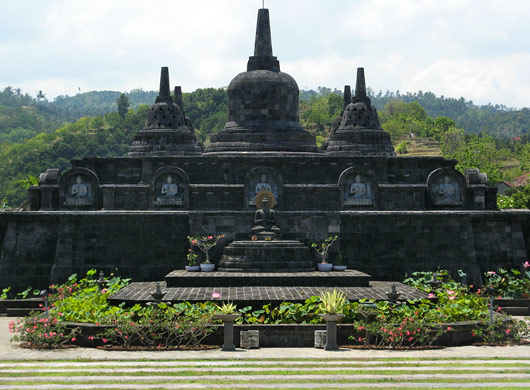

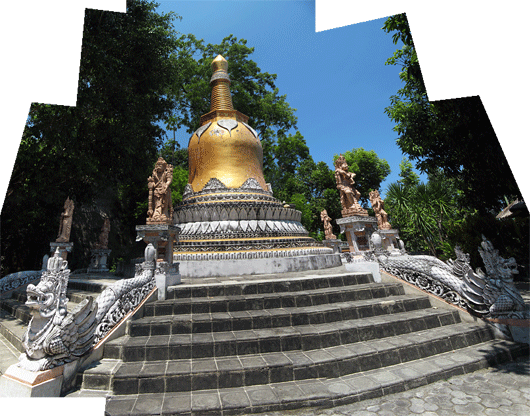
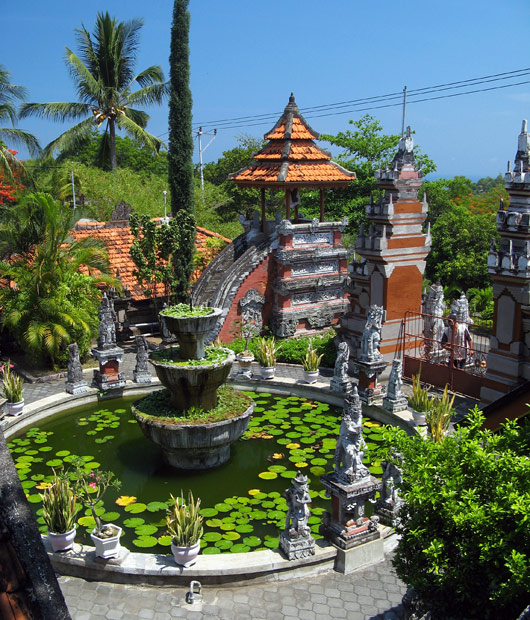
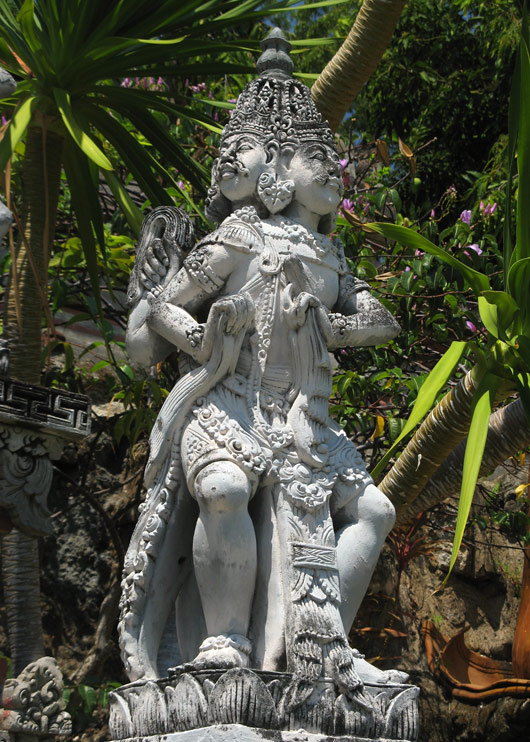


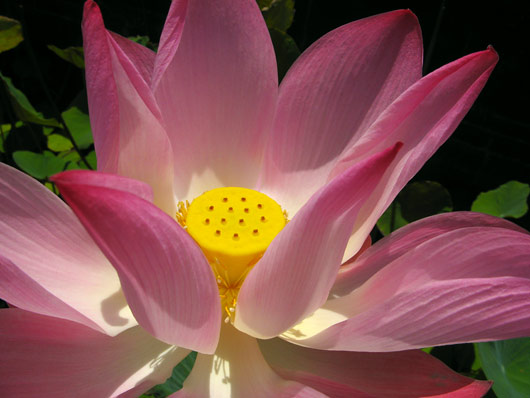
After a bit more than a week on Bali it was time to say goodbye to the sweet Balinese, and move onto the next island - Java.
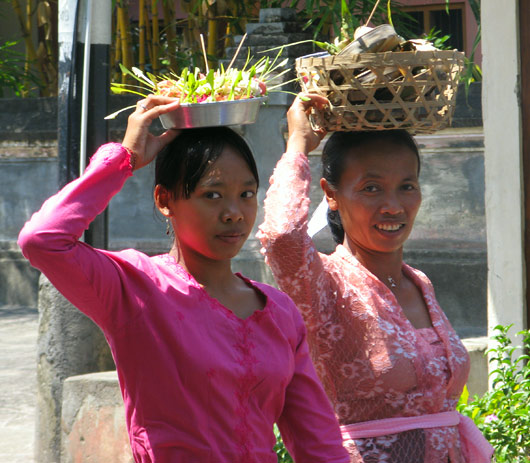
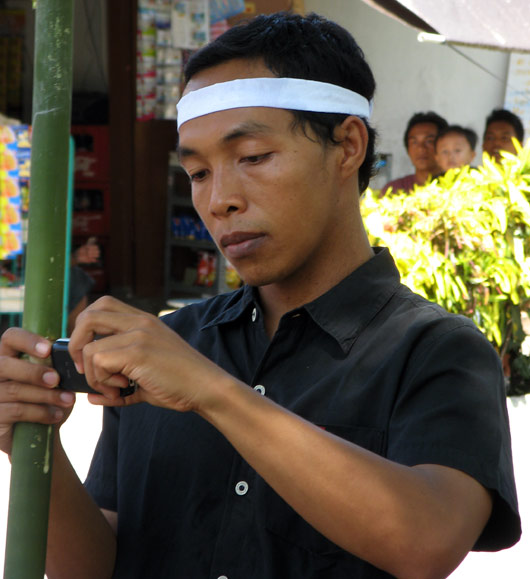
It is interesting to note that Java is one of the most densely populated regions on Earth, with the population density of some 1000 people per square kilometer. Considering that, we were pleasantly surprised to find the eastern part of the island relatively calm and airy. One of the first sights was Gunung Bromo, a volcano which is also considered one of the most breathtaking places in Indonesia. And to be honest, it was pretty magical.
We were lucky enough to arrive there on a sunny day while it is actually the rainy season here, in Indonesia. In the national park there were only a handful of tourists, so the place looked empty and even somewhat desolated, as if the time had stopped. Only the clouds were making their way up and down the collapsed caldera, and a couple of horsemen were there trying to sell us a ride up the slope of Bromo.
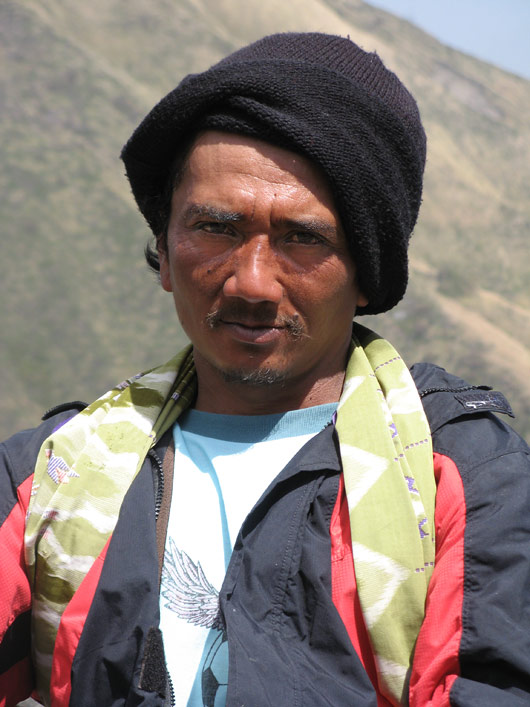
The crater base consists of grey coloured sand, so to get to the volcano we had to struggle a bit with our heavy bike, while the locals were whizzing by on their small bikes like flies.


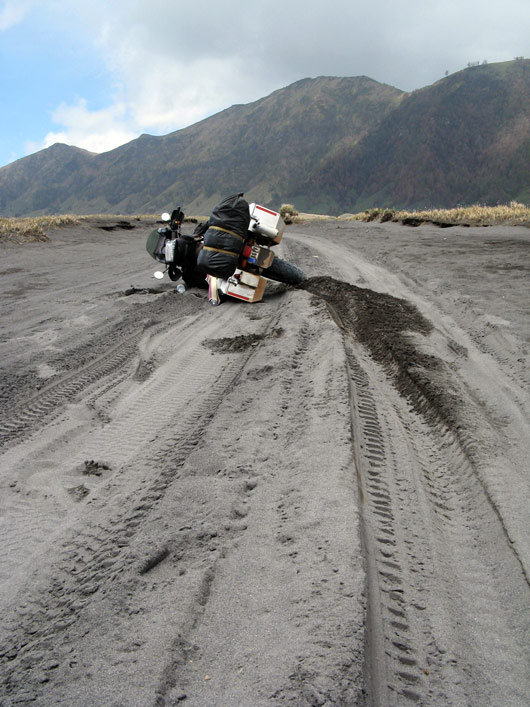
But we made it there, and we could take a peek into the smoking crater itself. It truly was an astonishing experience, to see (and smell) all that smoke and to hear it roar as it makes its way up through the Earth core.

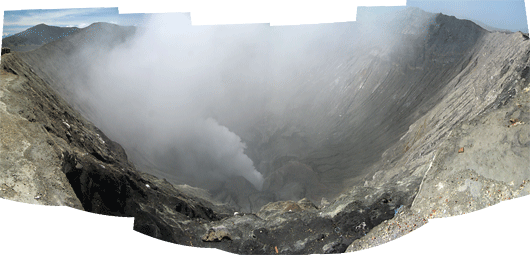


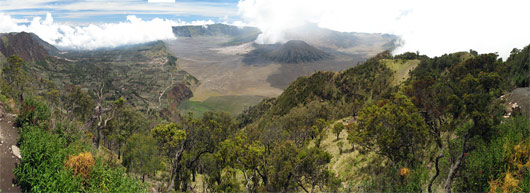
You can see Bromo and our riding around the area from the video below.
<object width="530" height="323"><param name="movie" value="http://www.youtube.com/v/wbvA_22TcF4&hl=en_US&fs=1"></param><param name="allowFullScreen" value="true"></param><param name="allowscriptaccess" value="always"></param><embed src="http://www.youtube.com/v/wbvA_22TcF4&hl=en_US&fs=1" type="application/x-shockwave-flash" width="530" height="323" allowscriptaccess="always" allowfullscreen="true"></embed></object>
As a background, we used a tune performed by a gamelan orchestra. Gamelan is something specific to this region (mostly Bali and Java). The term itselt does not refer to the group of people playing the music, but to the set of instruments, which have all been tuned to that specific set and are thus not interchangeable. They even say that there are as many different tonal scales as there are gamelans.
But there is more to Java than the volcanoes. Once again, since so many people live on the island, you can see traces of human action everywhere. We found the most stunning the sleepy mountain villages featuring modest houses and masterfully cultivated land - it is difficult to imagine the steep slopes that sustain agriculture (not only rice, but also potatoes and cabbages) here. The people are much more relaxed and don't come running to you with the endless "hello misterrrr!".
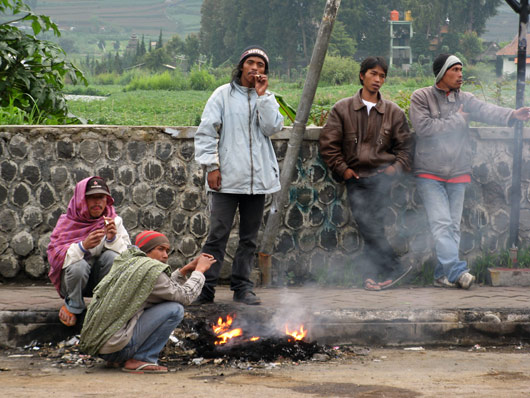
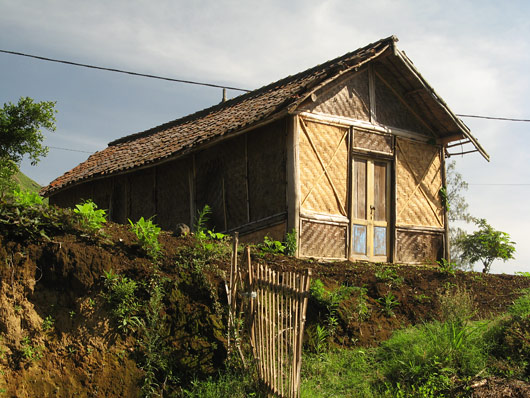
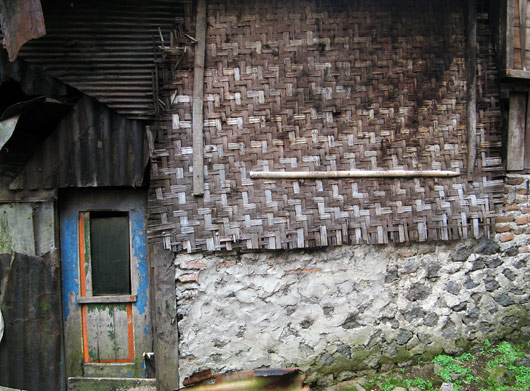
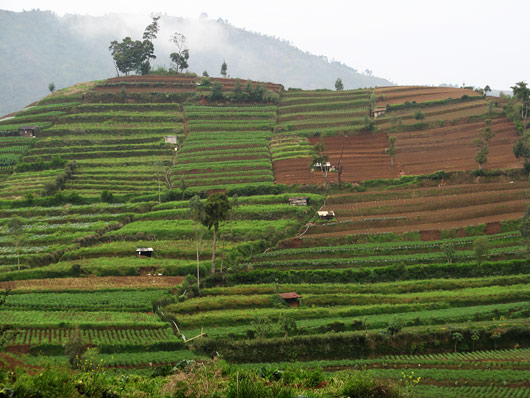




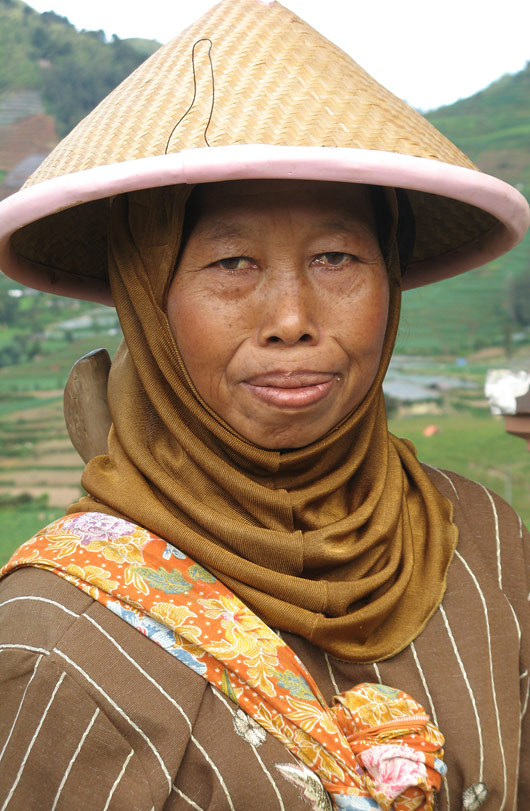
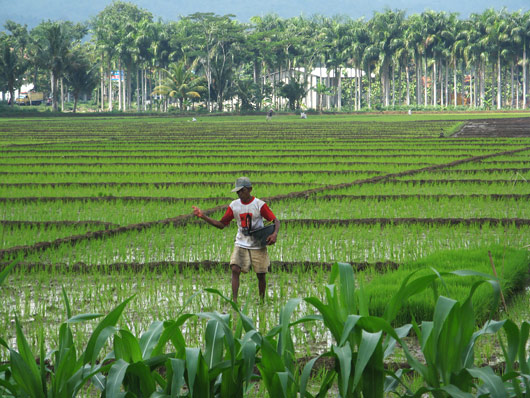
One of the coolest (literally!) experiences was the Dieng plateau, famed for its high altitude and steaming crater lakes. And cool it was - the hotel (rather a homestay) even provided us with two blankets and a termos with hot tea. It is weird how in the morning you can sweat like hell at the lower altitudes, but once you get to 2000 and up, it becomes so cool that you can even see your breath.
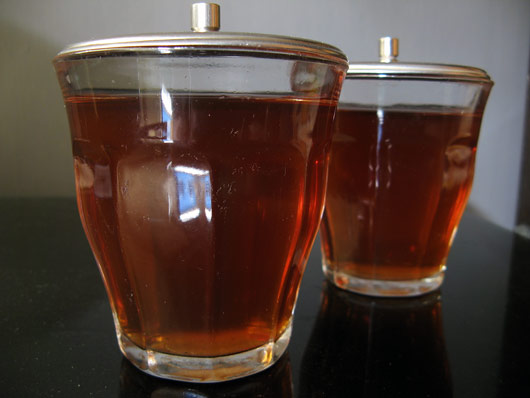



Dieng is a small village, but there are still at least four mosques. So on many occasions one can hear examples of koran recital.
.::LISTEN::.
One of these did not sound too good. Our first thought was that maybe a drunk imam had grabbed the microphone, but the Muslims do not consume alcohol, so maybe it was the faulty sound system:
.::LISTEN::.
So that's about the modest sightings. As you can see, modern Indonesia is truly Muslim these days, but it has not always been the case. There are things here that Indonesia is more famous for, and these are the Hindu and Buddhist temples of Prambanan and Borobudur, respectively. They were built in around the 9th century, and are funnily located so close to each other (maybe some 50 kilometres away, as the crow flies) that it once again makes you wonder how they could get along so well.
Prambanan's centerpiece is the platform containing huge temples for the main Hindu deities - Brahma, Shiva and Vishnu. Unfortunately, at the time of our visit many of them were under reconstruction (they were badly damaged by and eathquake a couple of years ago) and thus we are not entirely sure if they are really worth the 11 USD entrance fee applied to foreigners.
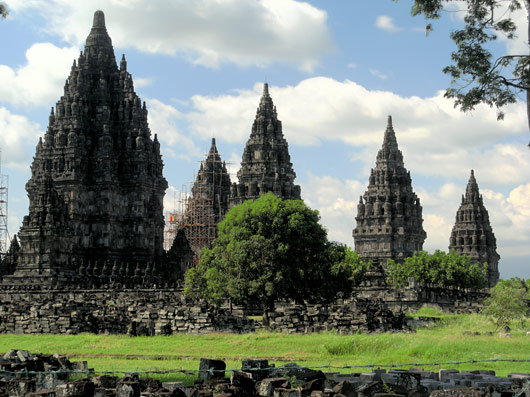
Borobudur left us a better impression - it just looked cool and contained a wealth of intricate stone carvings. But it was crowded with tourists, many of them locals (who actually pay some ten times less than foreigners), climbing on the precious statues to pose for a Facebook picture and sticking their hands in the bell structures atop the temple to touch the Buddha statues inside them. It felt as if we were in a zoo. I do not know if the temple itself is considered sacred, but something should be done if we want this World Heritage listed site to remain intact.

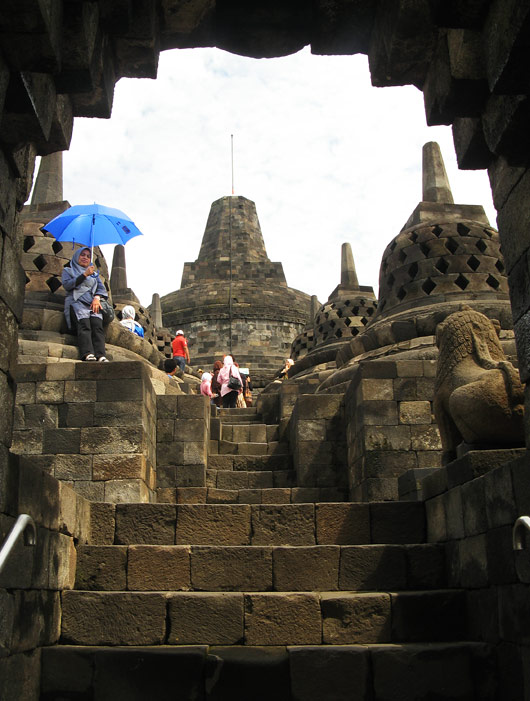
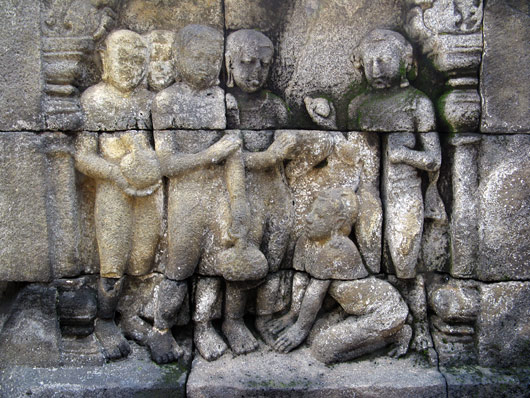

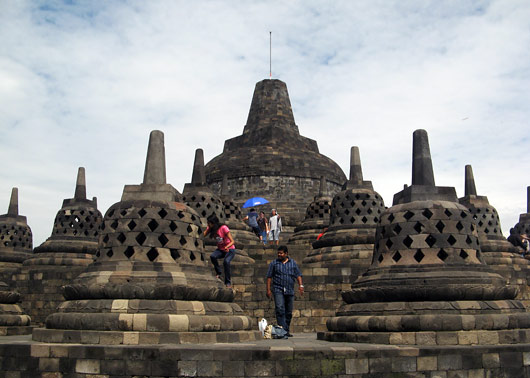
As we reached central Java, the population grew denser, and the traffic just became mad. It is not chaotic, not at all, it is just that different rules apply here that contradict the rules we have been tought. One of them is related to overtaking. According to our experience (observing others), overtaking is allowed (or even better, expected) even if there is someone already overtaking you, in front of you, or if there is someone coming in your direction. Normally it all works out fine (after all, so far we have not seen any accidents except for a couple of trucks driven off the road), but one has to beware of the buses, because what counts here is your size - pure physics - so if you see a bus coming towards you, do not expect it to change lanes. It will flash lights or beep the horn, and you will have no other choice but to get the hell of the road and out of its way! So, yes, the traffic is dense here, and it must be the worst we have ever seen.
Through some hundred kilometres we finally arrived in Jakarta, the Indonesian capital. So if Java is considered to be the heart of the Indonesian nation, Jakarta must be the very center of it. The first thing we noticed was of course the mandatory skyscrapers, some of them pretty nicely designed.
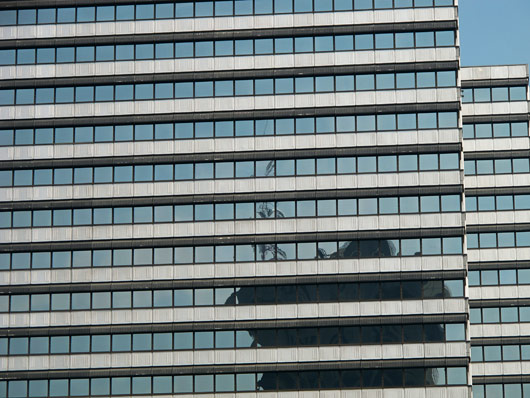
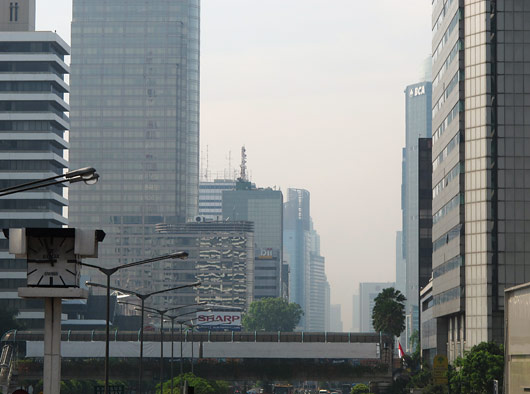
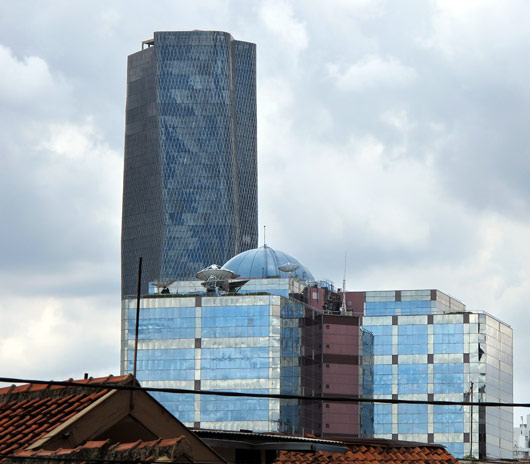
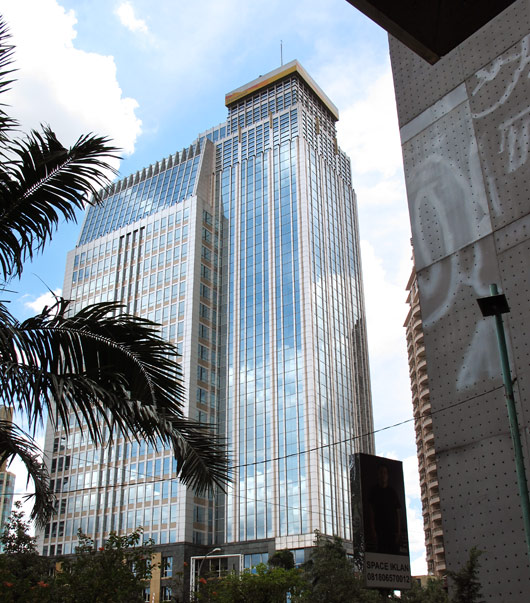

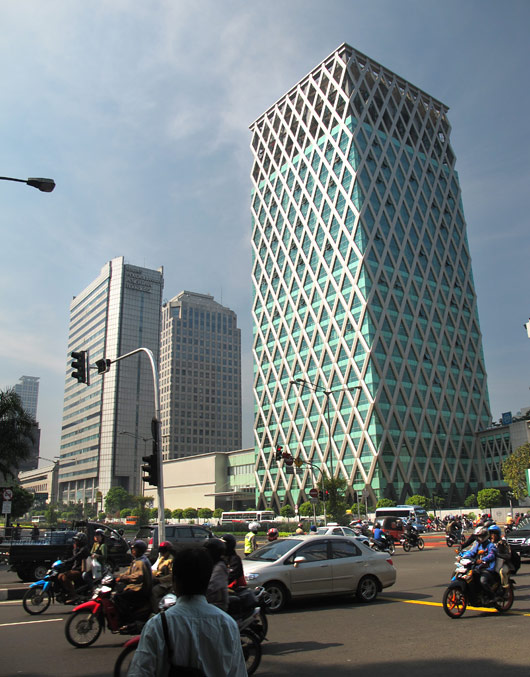
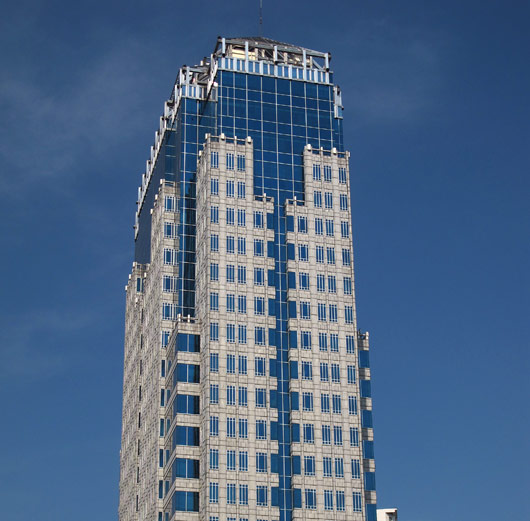
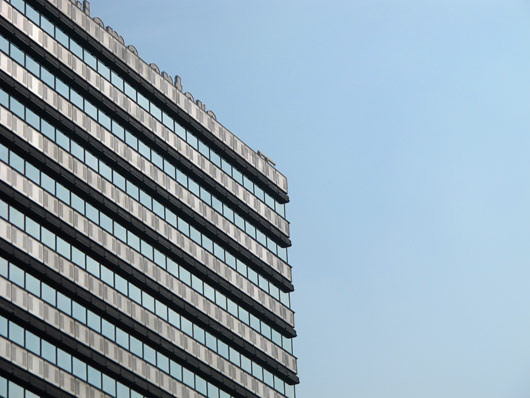
But below them modern monsters, life works at a different pace, interlaced with religion and bound by other rules. There are mosques and prayer rooms everywhere, starting with gas stations and shopping malls, and ending with hotels. This is how a prayer room looked like in our hotel.
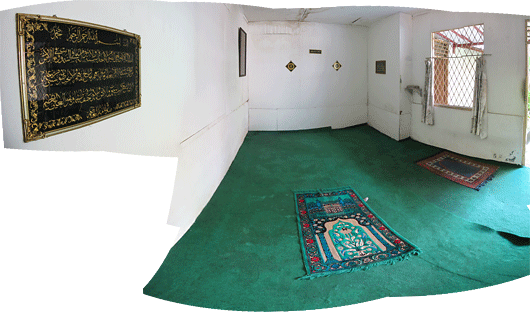
Beneath the skyscrapers people live their simple everyday life, wearing flip-flops (even when riding a bike) and smoking a hell lot of cigarettes.


There are lots of cats running around on the street, and the architecture is interesting, but reflects the poverty.
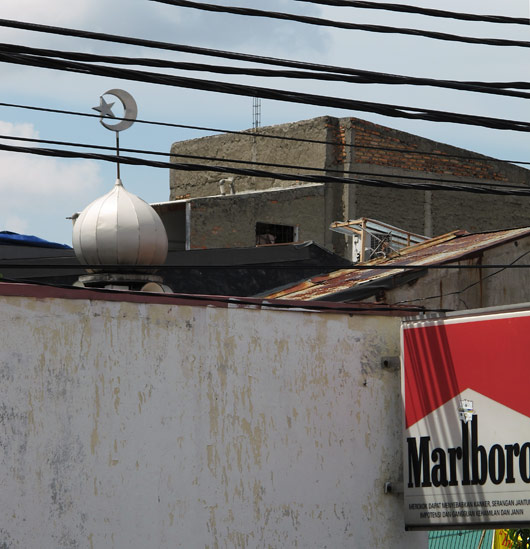

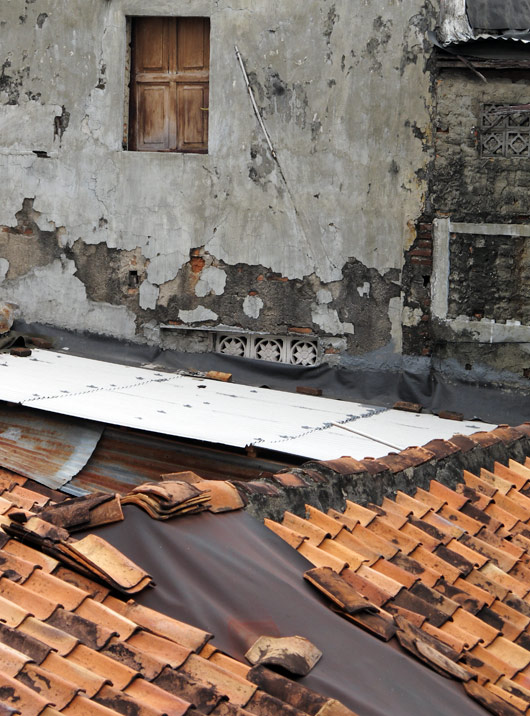

One thing that caught our attention is that although we sometimes look towards Asian countries as the big consumers and pollutants of the future, today's Indonesian's ecological footprint is for sure smaller than ours, although we pretend to be environmentally aware and so on. They do not use electricity to dry their clothes (rather, they hang it on a rope or place it on rocks so that the sun would dry them), and availability of fresh juices reduces the quantity of plastic packaging. They use a scoop to wash down the toilet and to wash themselves, thus reducing fresh water consumption. Of course, it is not because of their awareness - mostly it is due to the economical and cultural background, but still!

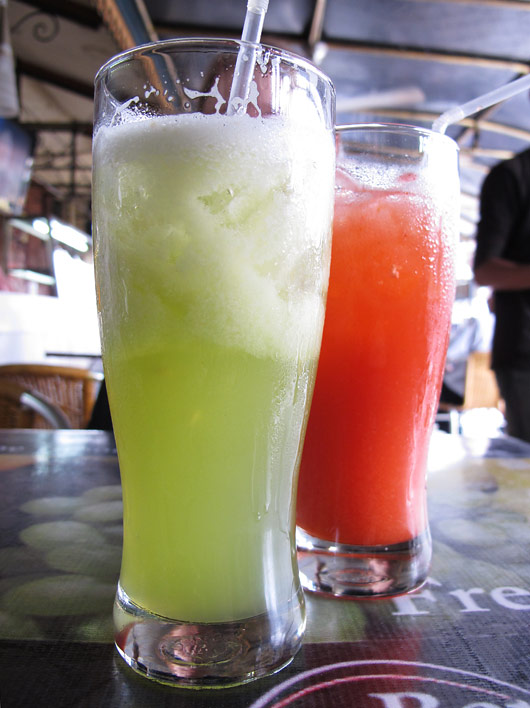
One of the highlights for us when visiting Jakarta was meeting a local biker (an ADVrider!) Bram and his wife Griska. When they came to meet us in our hotel, they brought us two jackets with the emblem of a local biking forum, some food that Bram had cooked himself (we had expressed or scepticism about being able to reach his Chinese food restaurant located in the suburbs, so...), and Griska even had a special gift (local style accessories) for Kariina. It was all totally unexpected, because normally it is the guests who bring the gifts. We were even more stunned when Bram took out a sheet of paper which had 28 questions related to our trip. He really is dreaming of doing it himself, so we were extremely glad we could share our experience.

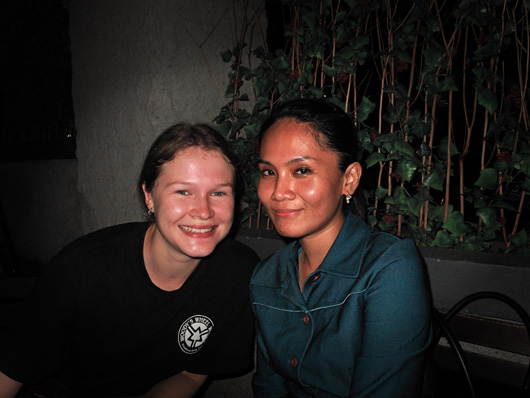
Our last couple of days in Jakarta were rainy (it is rainy season after all).
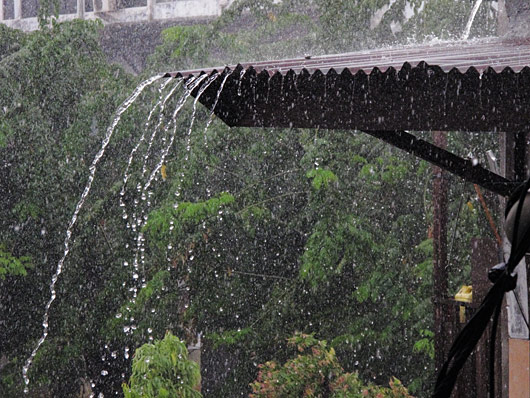
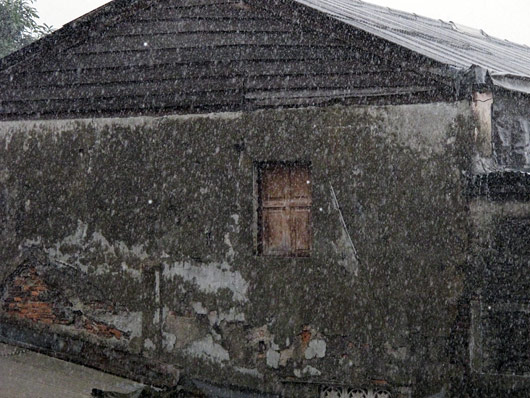
And the morning we left Jakarta we were woken up (once again) by koran recital, at 4 AM. But it sounded so good that although my body was still asleep, my mind seemed to be so clear as if it had been some sort of spiritual enlightenment. Being there, of course, gave a powerful impression as the city was slowly waking up and the morning fog was rising from the streets with deep blue clear sky above...
.::LISTEN::.
So we left Java, taking a ferry (for the last time in our Indonesian island hopping) to Sumatra. As we were leaving the port we could see (too) many rustbuckets standing waitning for their turn there. Really, no surprise that so many of them sink.
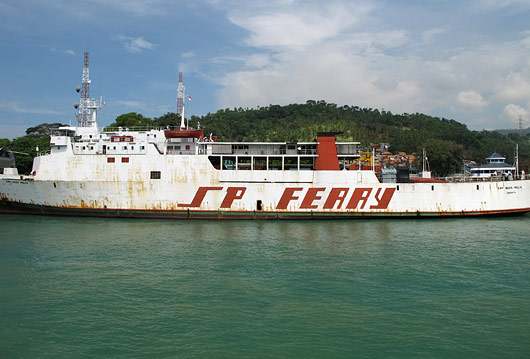
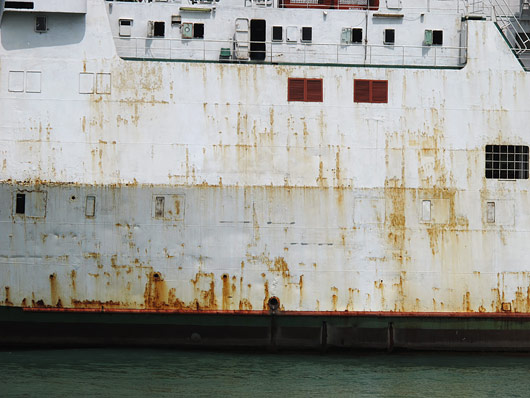
One young guy caught our attention by trying to swim first next to, and later after the ferry as it was leavig the port - a dangerous thing to do, considering that boats have propellers both in the rear and on the sides (for manouvering in the port). But someone threw him a banknote, so he swam away with it.

The crossing was smooth, and the elements of an Indonesian boat ride were all there, meaning the loud Indonesian pop music coming from the pirated CD store set up on the car deck, and surely lots of people wanting to get acquainted with our bike.
.::LISTEN::.



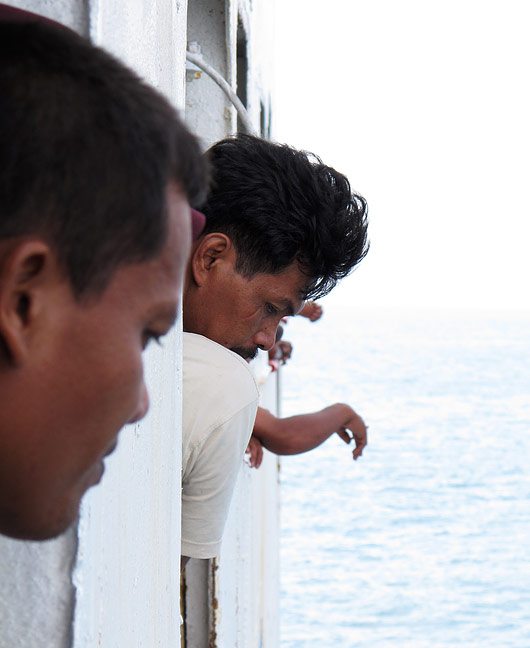
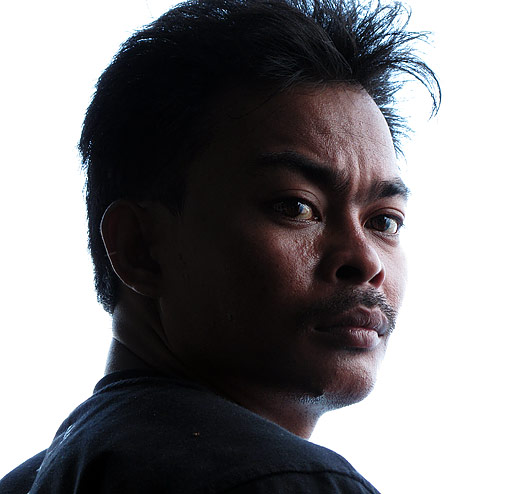
Finally we arrived on Sumatra which is four times the size of Java, and just a quarter of its population. It sounded like a promising fact, at least we imagined there would be less traffic and more air lo breathe.
And that is exactly what our first impression was. Sure enough there were the shimmering rice paddies and sleepy villages that we had already seen before, but somehow the overall atmosphere was much more relaxed, yet more impressive.
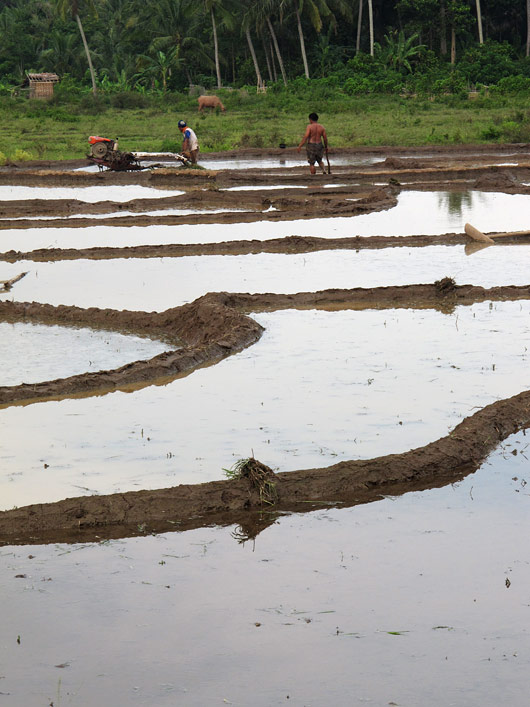
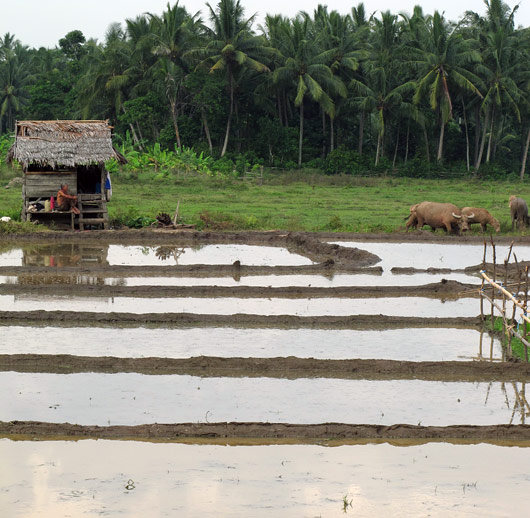
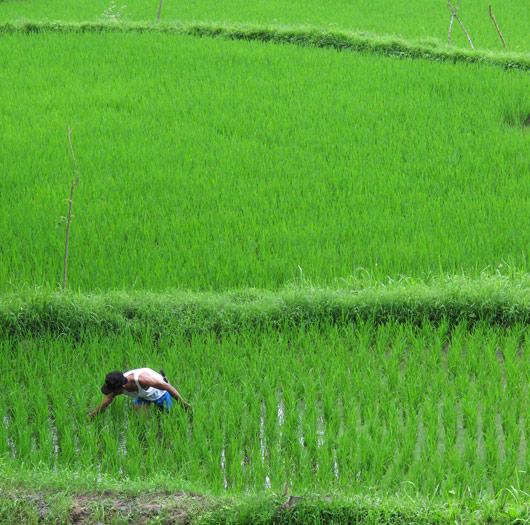

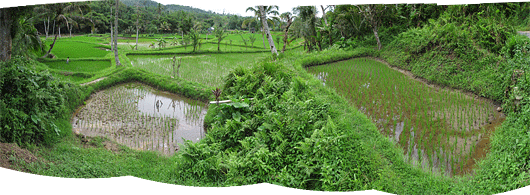
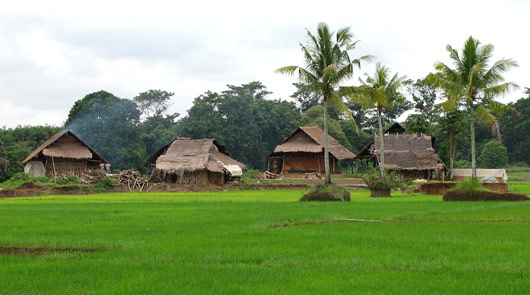
The air was in fact so fresh that after the madness and congestion (that always comes hand in hand with dizzying exhaust fumes) of Java, and especially of Jakarta, it felt as if we had stepped into another world. We spent our first night on Sumatra in a small town of Kalianda where we probably were the only foreign tourists, and it greeted us in a majestic way, with a thunderstorm, perhaps reminding us that here, more than in many places in the World, life is reigned by the forces of nature.
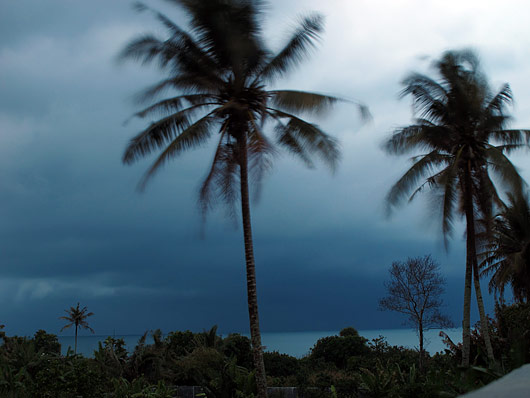
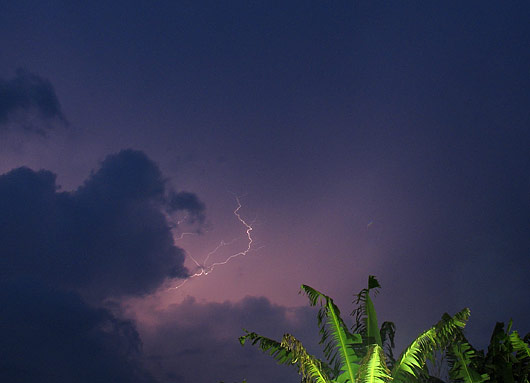
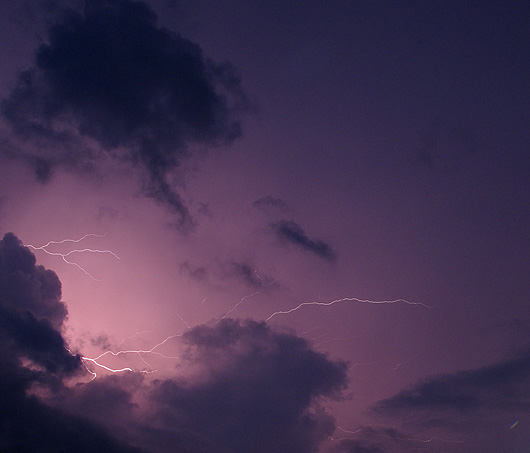
The following days proved us that this island, which has not been frequented by foreign touristed too much after the 2004 tsunami which devastated Banda Aceh in the north, is a true chocolate box. Since we did not have a map, we decided to take random roads leading north, and this is how we ended up riding up the west coast, passig by (once again) picturesque fishing villages.
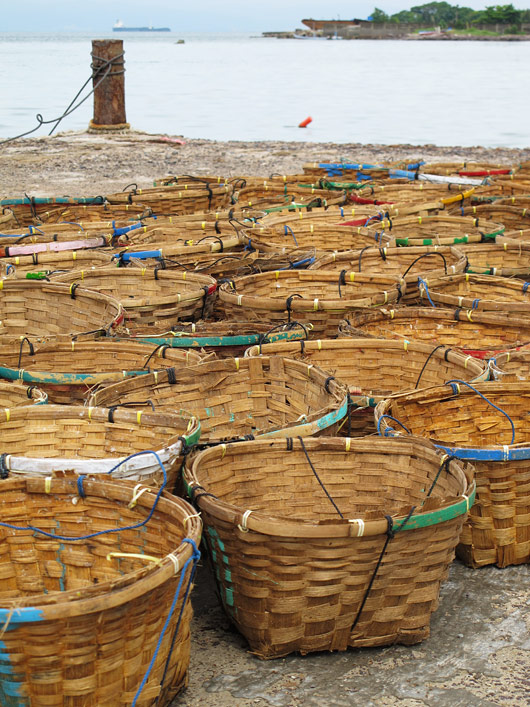
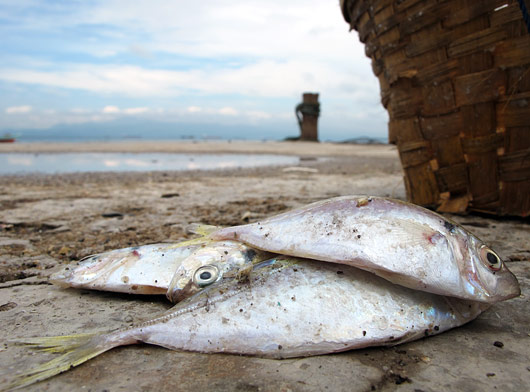
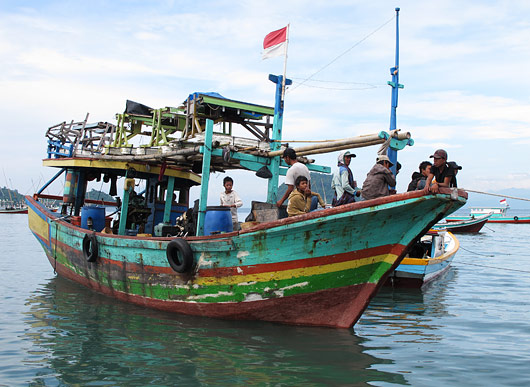
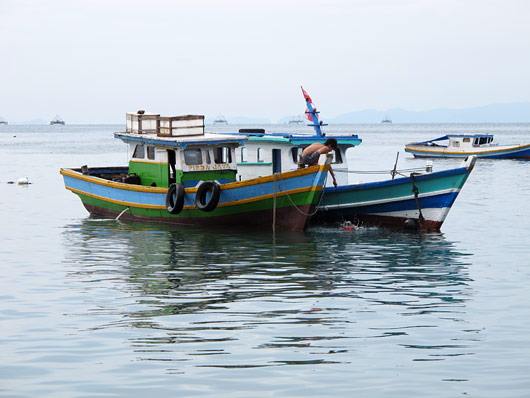
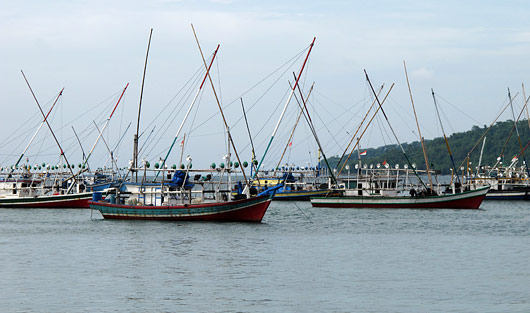
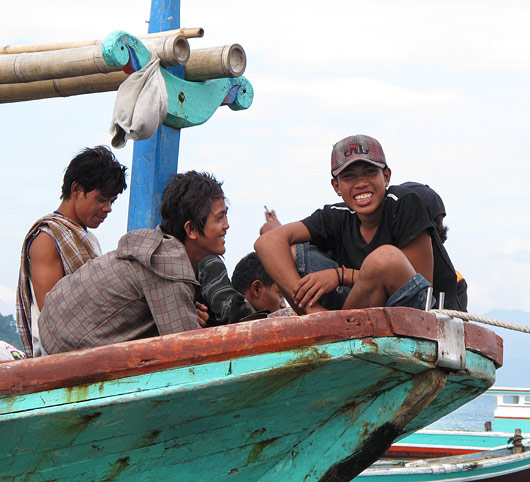
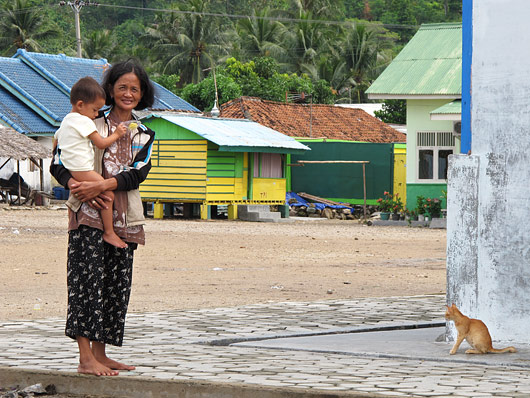
Click to enlarge panoramas:


Once we stopped by the road, amidst some coffee plantation, to taste the durian, a famous fruit that the locals love but which is often resented by foreigners. Well, it sure has a strong smell (quite good actually), but the inside is somewhat spooky, visually reminding of rotten eggs. Let's say that if you ignore those associations, it is not bad, but it did not necessarily leave us craving for more.


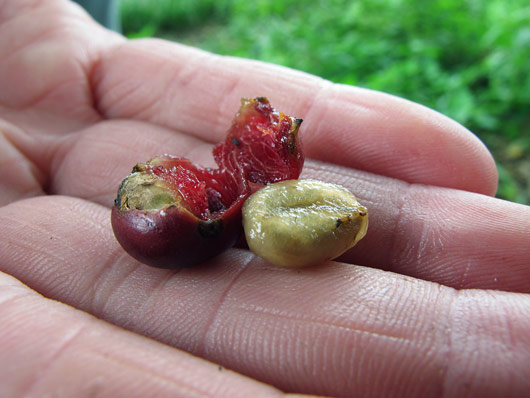

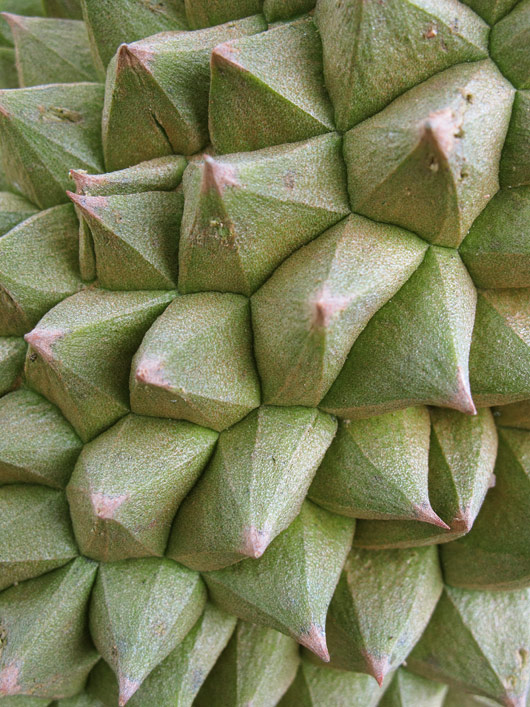
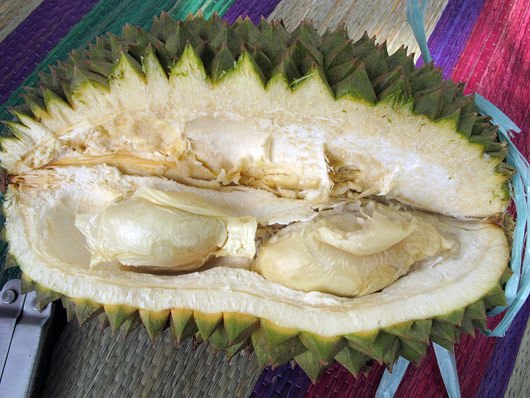
A thing that appealed to us the most at that roadside stop was the weird sound some bugs were making in the bush, which reminded of tehcno or electro music.
.::LISTEN::.
One day, by late afternoon we stopped in a random village, and as we set off to look for some bakso - a soup most often served by street stalls, we first ended up buying some deep fried bananas from a similar looking stall.


We continued our quest through the village, and at some point we heard some music. Soon enough we were invited by some local ladies to join their band, but after they had performed us a tune or two, they asked in a shy way if they could take a picture with us. Our positive answer was followed by a half-an-hour photo session and lots of giggling. We sure looked weird to them, as we are much taller than the locals, and we do not speak much Indonesian. Luckily, one of the ladies was an English teacher at the local school.
Here is their music:
.::LISTEN::.
And here are the results of the photo session:
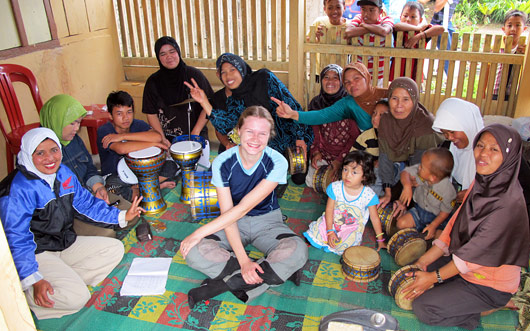
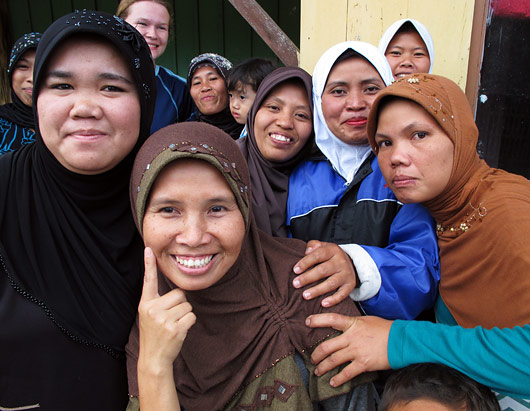

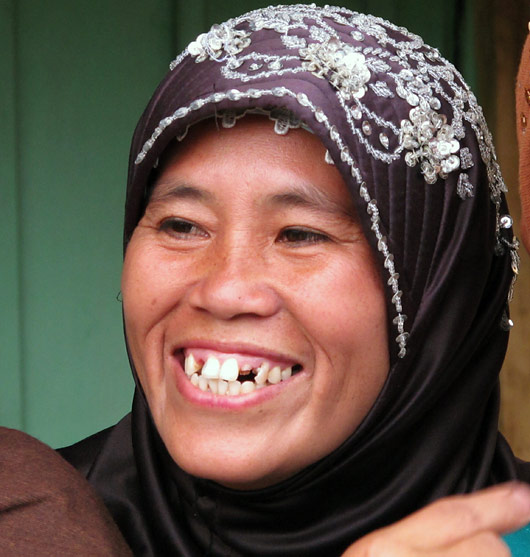


Luckily, after so many deviations, we could find a place that served bakso.
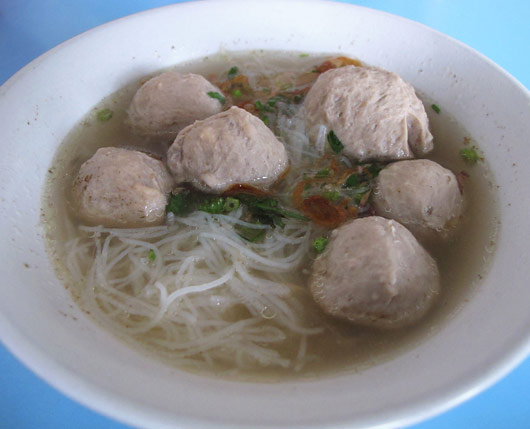
Before we reached the centre of Sumatra we passed through some more wonderful scenery - rustic villages, rice paddies, nice beaches and lush jungle, and we really could not be but in love with this island.
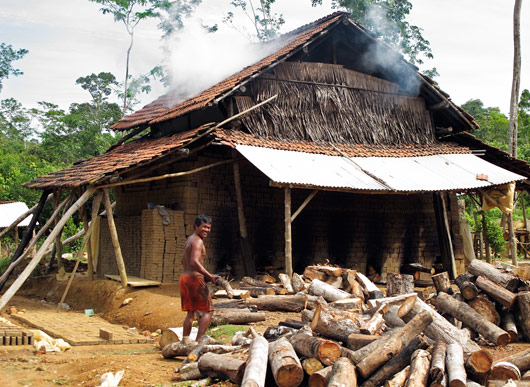
(A brick factory in Indonesian style - they burn the bricks under specially built building)


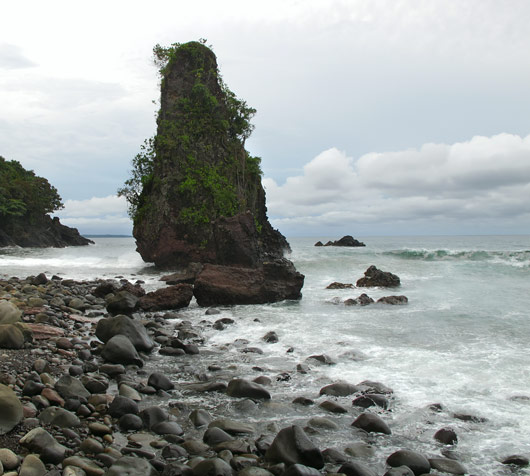
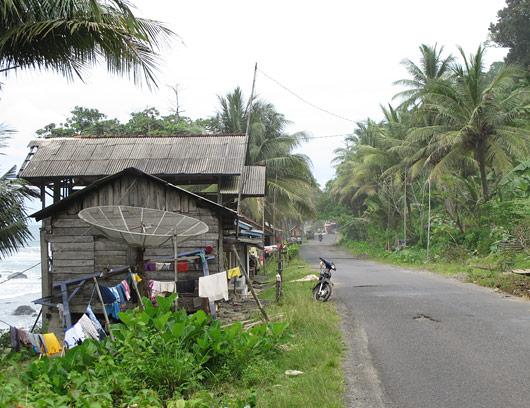
Typical coastal village street.

A restaurant in one of the villages.

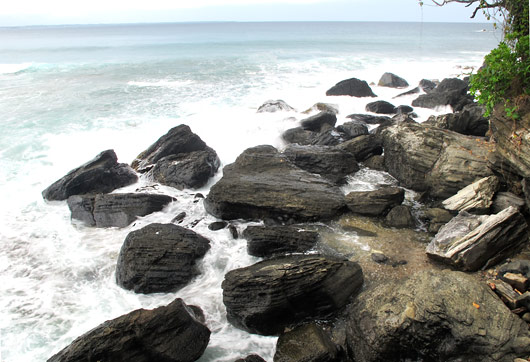
Sumatran coast (click to enlarge the pics and panoramas)

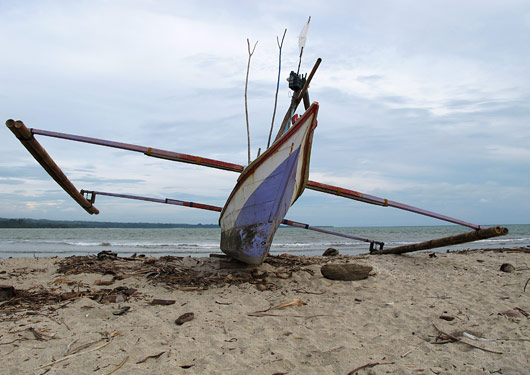

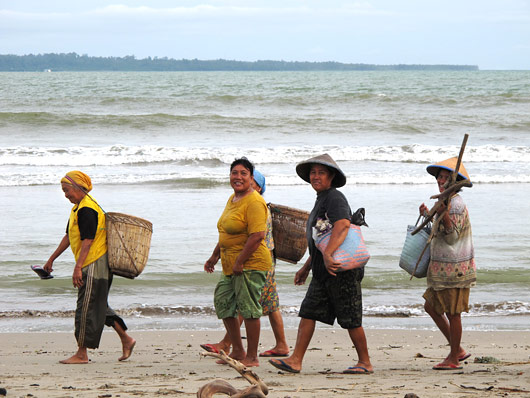
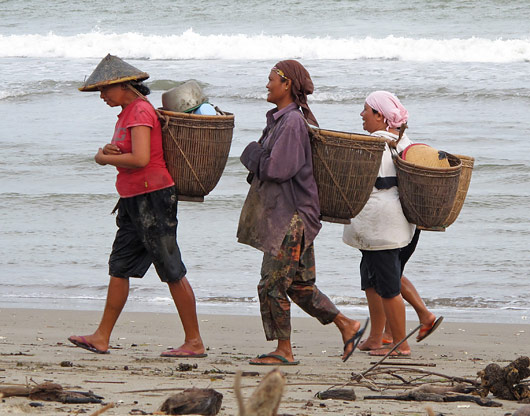
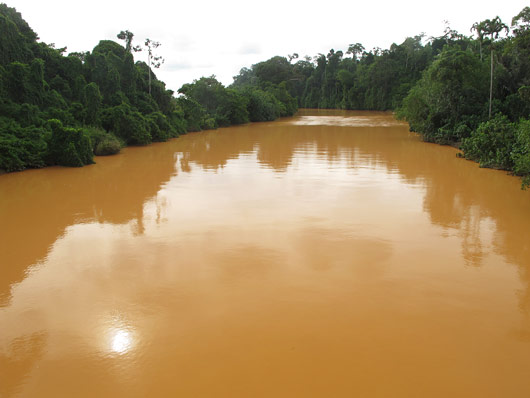

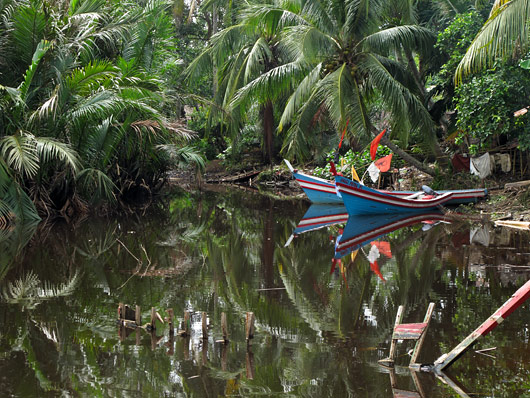


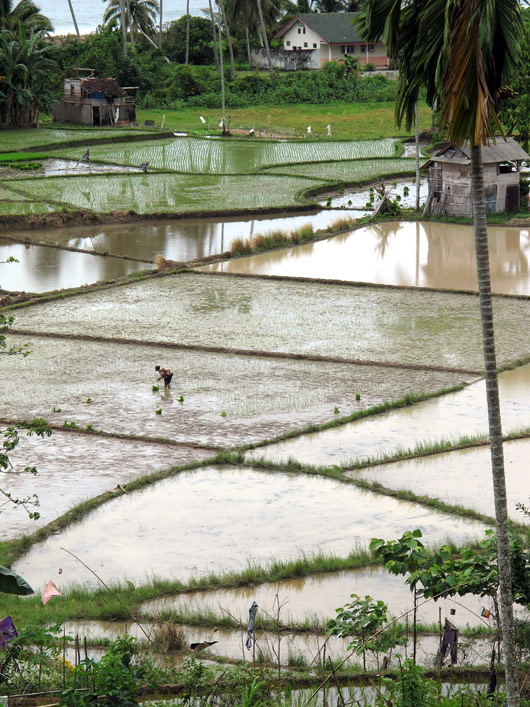
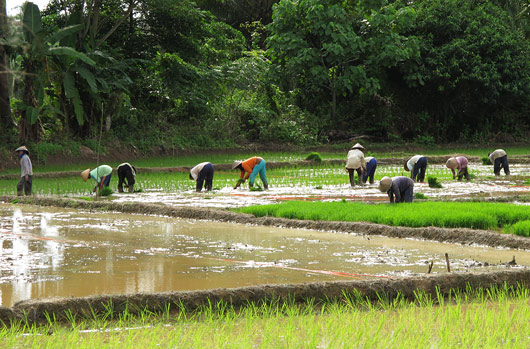
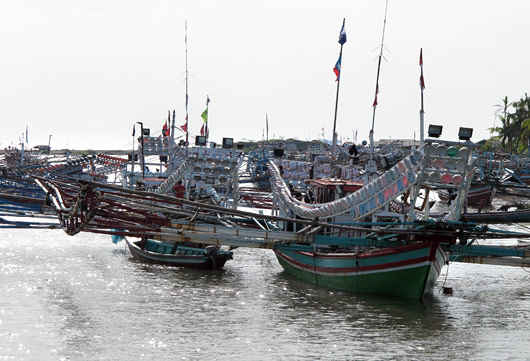
Night fishing armada at the port - click on the pic to see how many lights each boat has!
Caught fish:
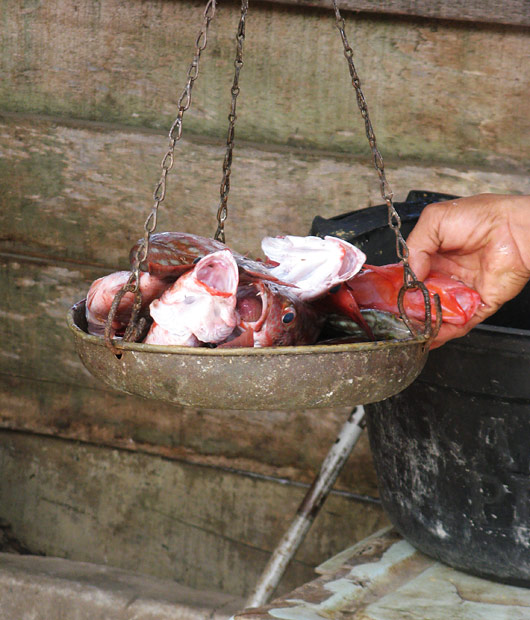

The fauna was amazing as well. We could see many species we had never seen before, and one of the highlights was saving an interesting looking turtle from being killed on the road.
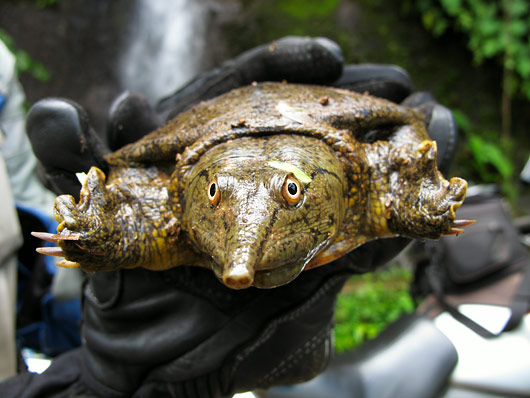
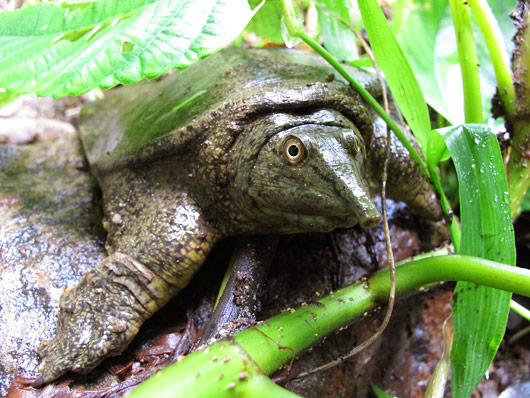
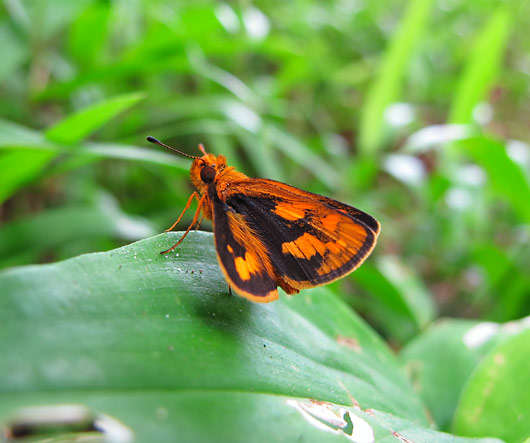

Click to see small crabs in detail:
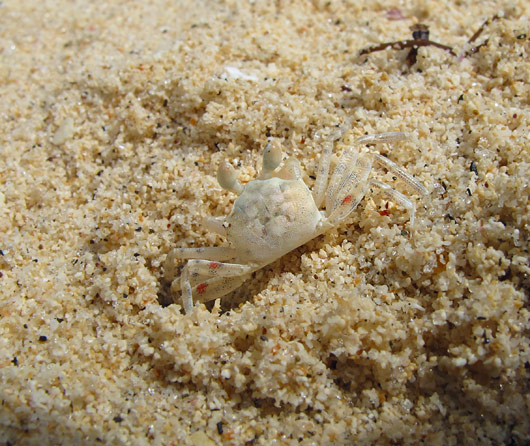
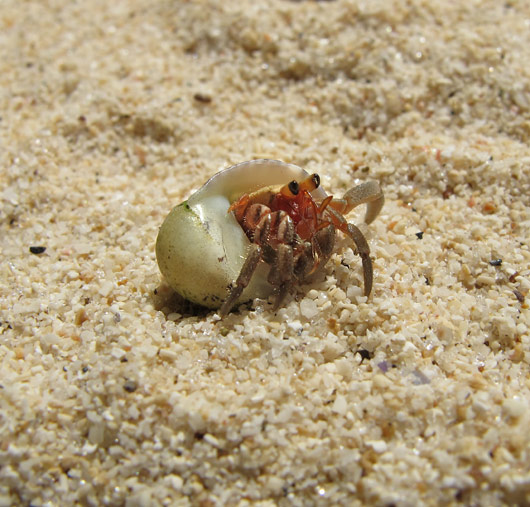
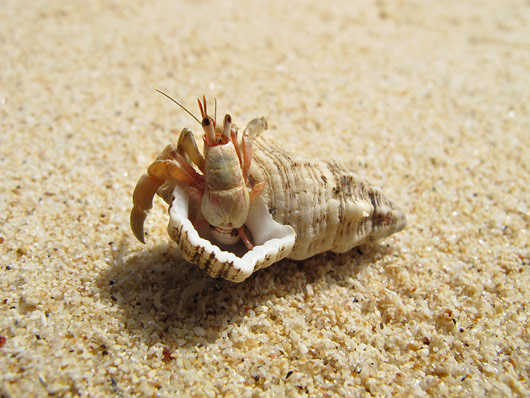
And a tiger warning sign on jungle areas we rode through:

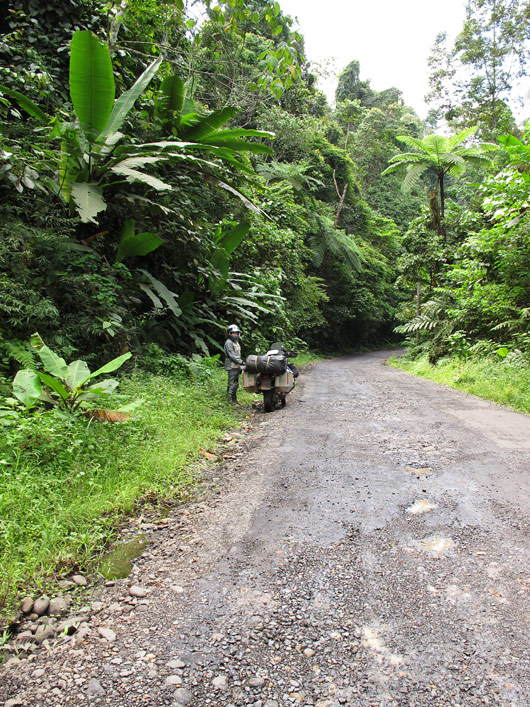

While in the jungle area, we heard some funny noise, and recorded it. First we thought it was monkeys, but might also have been some birds:
.::LISTEN::.
The people were ever welcoming and curious about our bike. In fact, their curiosity is never agressive - normally they will gather around you and just stare at you, not intruding into your precious personal space. Its is after you make the first attempt to communicate with them, they will become very lively and ask a hundred of questions about you and your bike. Some of them, though, will not want their pictures to be taken. The children, of course, are not so reserved, but ready to pose for a picture whenever you take out your camera.

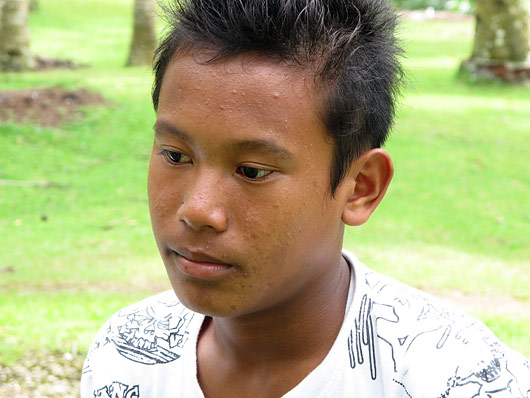
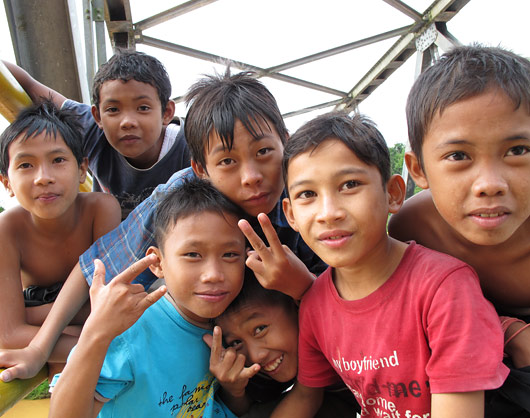

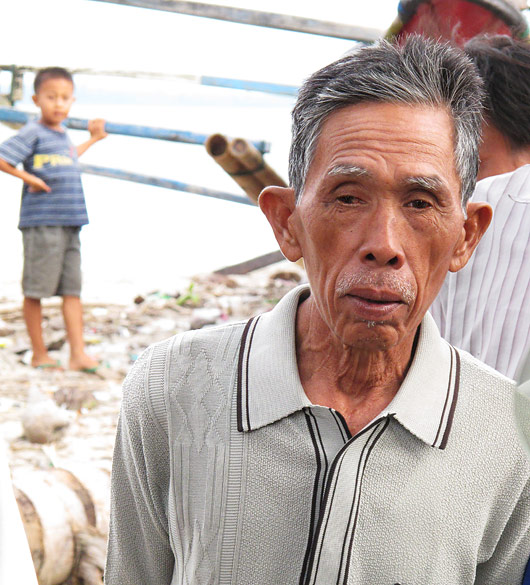
Everywhere we stopped, local crowd started to gather around our GS for a "close inspection" - most of the people hadn't seen such a big bike in their life (their local bikes are all scooters around 50-150cc):
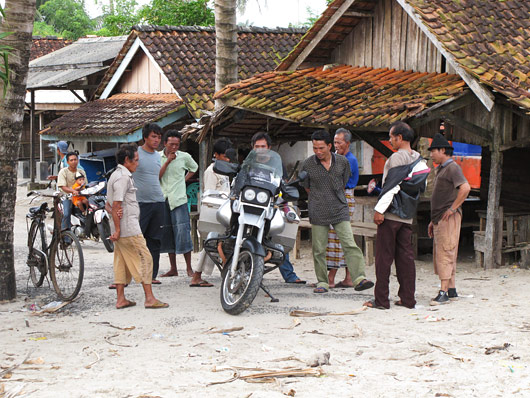
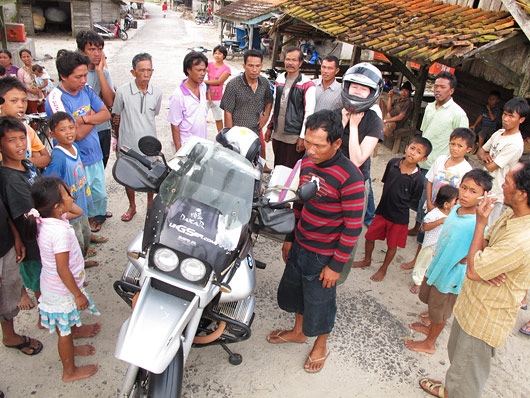
In the centre of the island we were greeted by Padang, the biggest city on Sumatra's west coast. The first thing that struck was the abundance of buildings that are about to collapse. Later we heard that there was an earthquake just a couple of months ago.
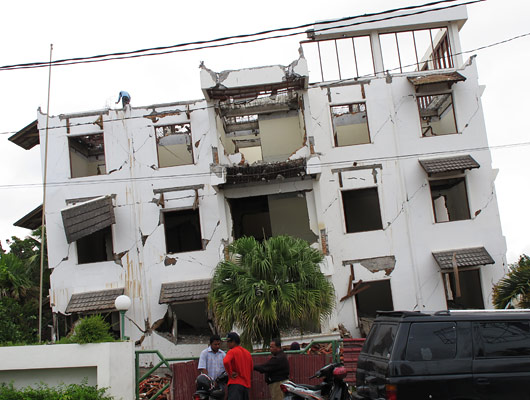
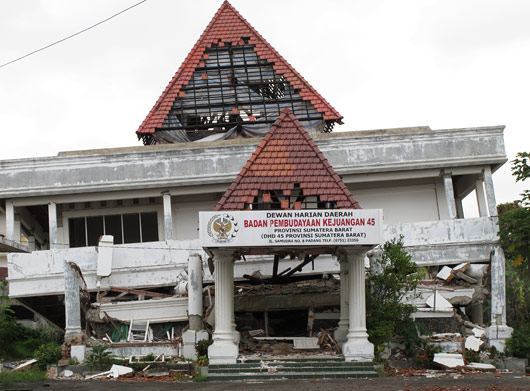
But more than looking at those ghostly buildings we enjoyed a visit to the harbour which is home to a great number of (surprise-surprise!) rusty boats, which obviously does not stop them from going to sea. The work was going on, so they won't be retiring too soon either.

(click to enlarge pics and panoramas)
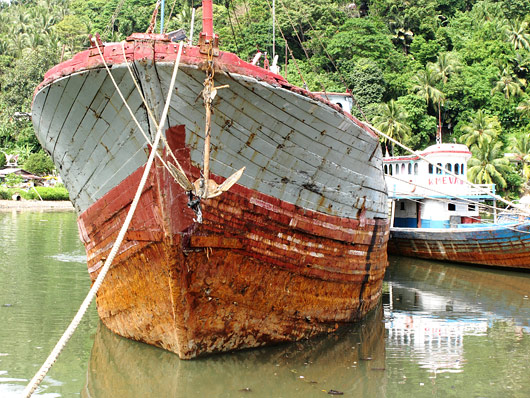
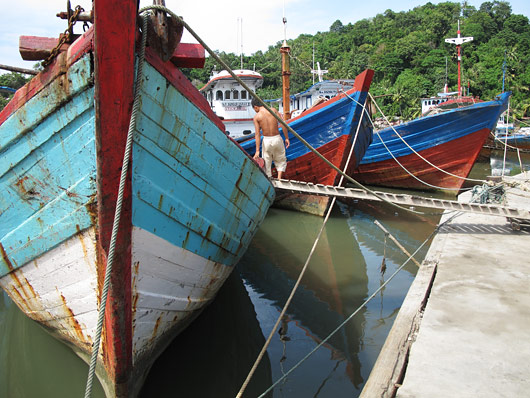
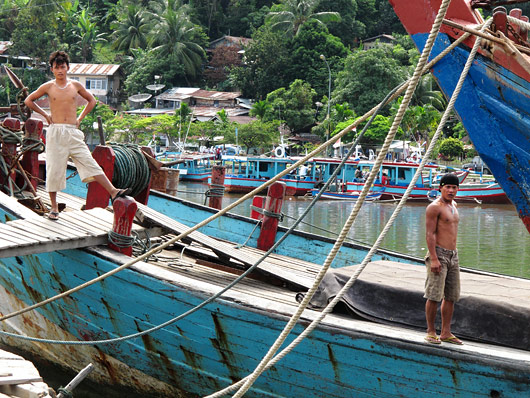
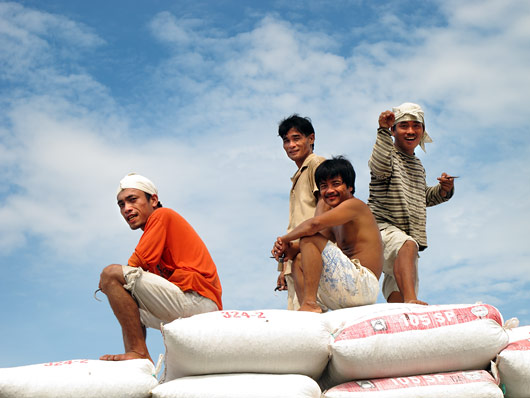
It was also nice to walk along the promenade, and to see local fishermen pulling their nets out of the waves, and selling their fresh catch. Some local folk were very eager to chat with us, so we also had a bit of a cultural exchange.
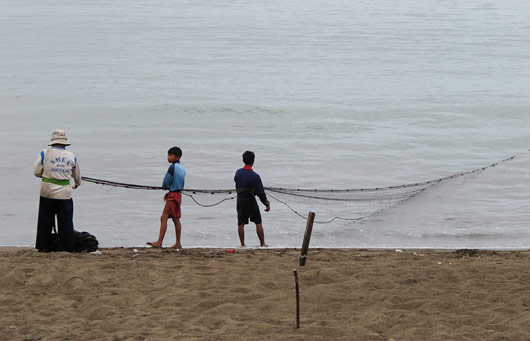
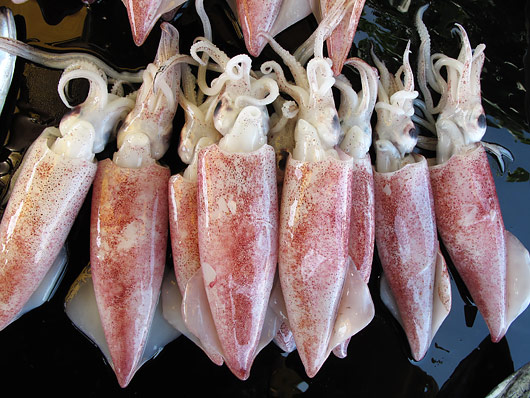
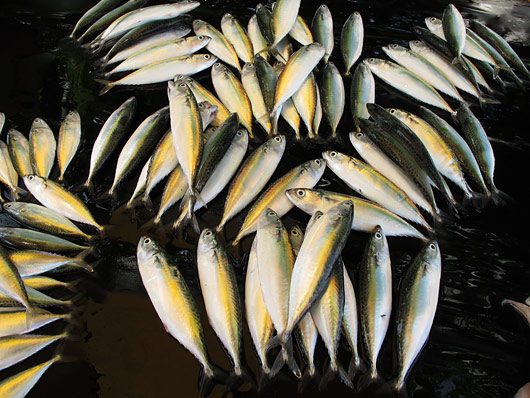

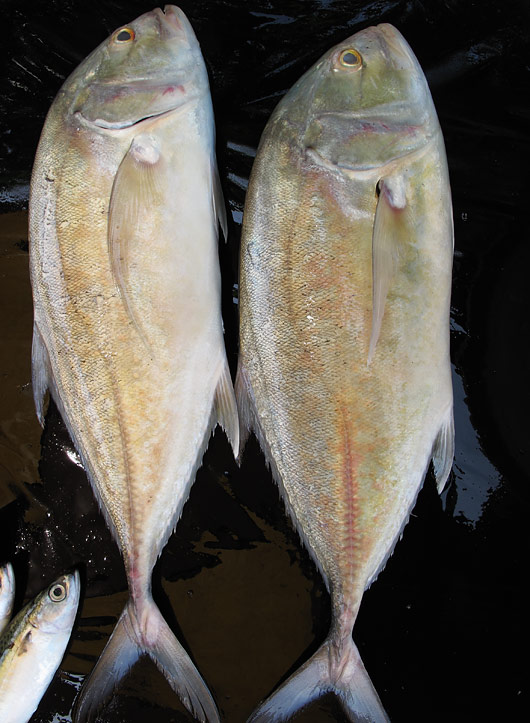
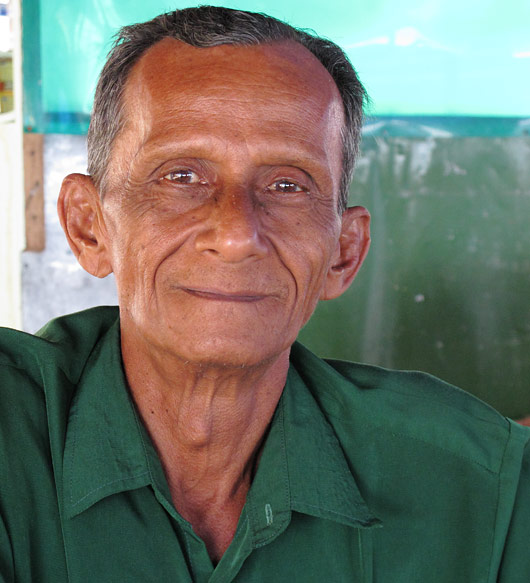

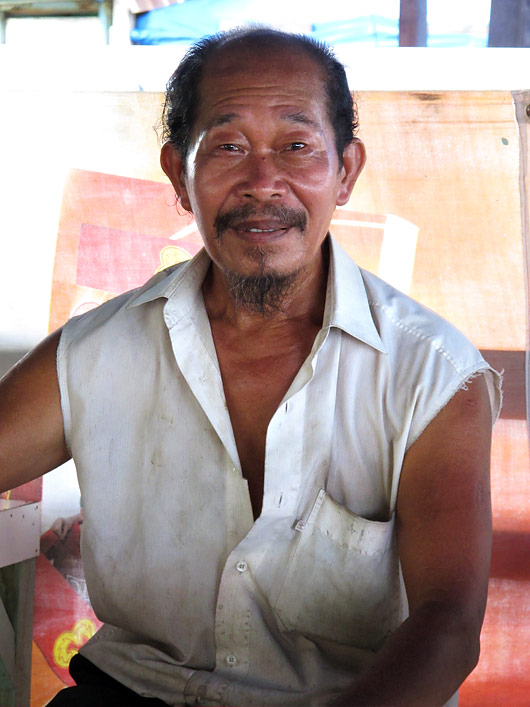
Bukittinggi, some 930 meters above sea level, is the main tourist town of the area. Sure it is situated between three volcanoes, and sure it is a great base for tours and treks in the nearby area, but what's so special about the town itself? It took some time to figure it out, but we did. It has a lively market selling lots of colourful stuff from fuits and veggies to dried fish and produce we could not identify.

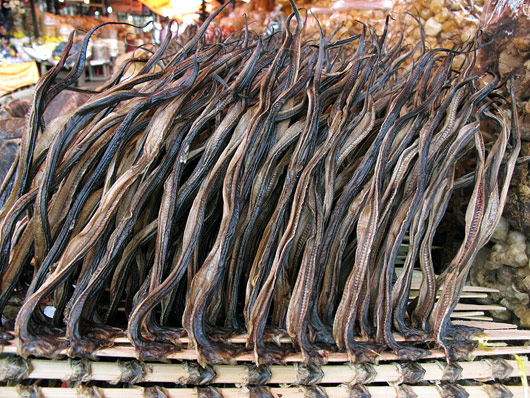

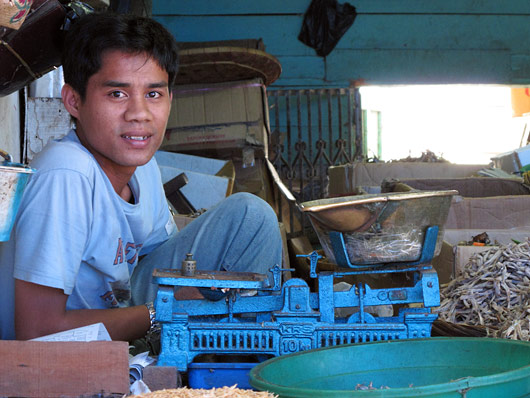

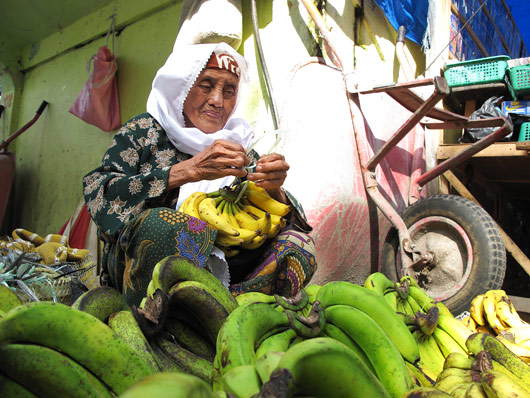
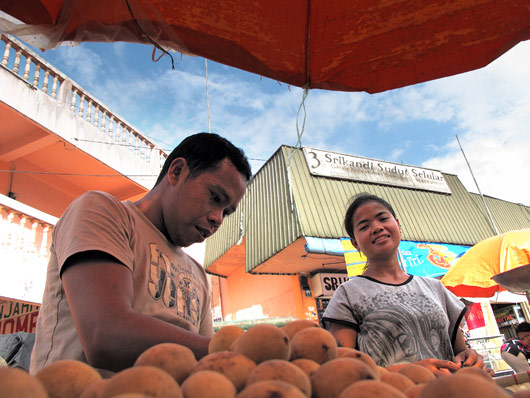
We also tried some local fruit that from the distance looked like small potato, but the taste of which actually reminded us of rambutan which we really like. It is called longkong.


Walking back to our hotel we met some interesting looking people.
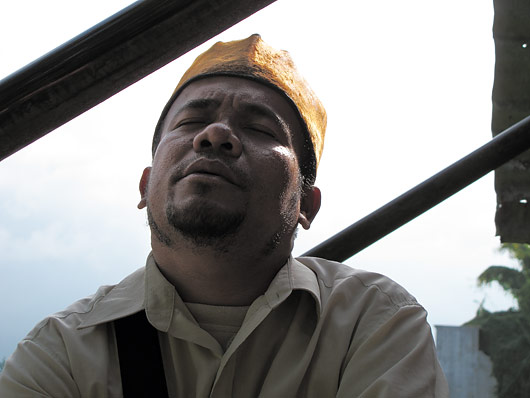
A singing blind beggar.

Another blind woman begging on Bukittinggi street.
Local people were very warm:
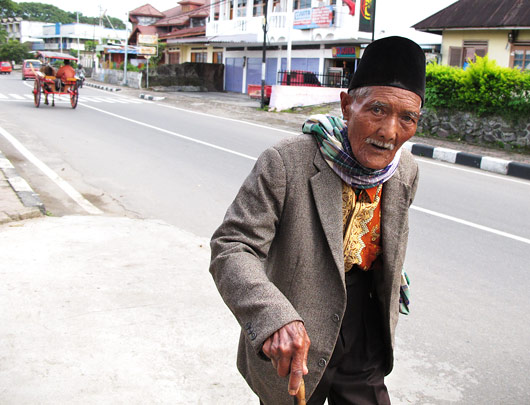


Some ride around on stylish retro Vespas.
Locals wanted to pose with the big bike and white skinned tourists:
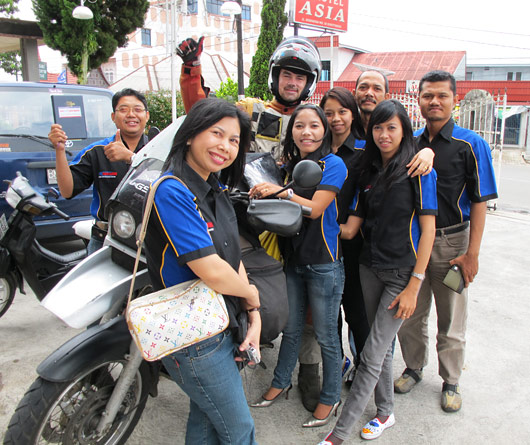
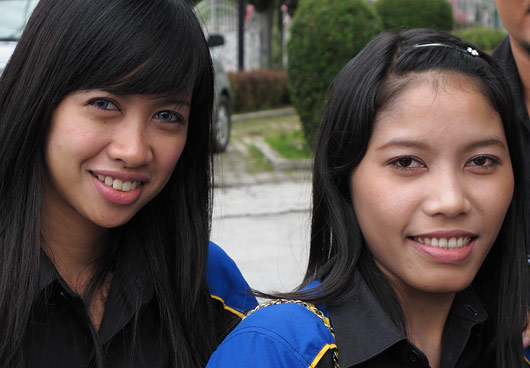
And they were slightly dissapointed when I said I'm married.
We spent the night wandering around in Bukittinggi's panorama park which offered nice views of the nearby Sianok canyon and of the volcanoes. We also met a monkey, and a young muslim couple.

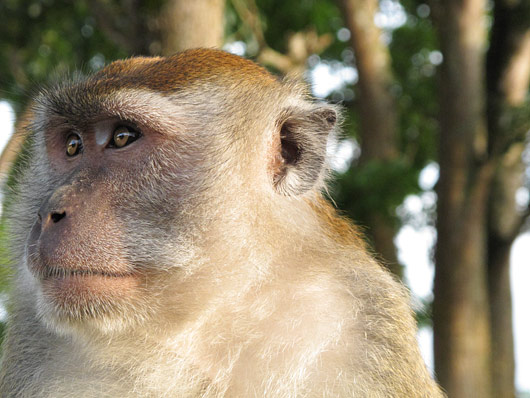

Views from the city park:
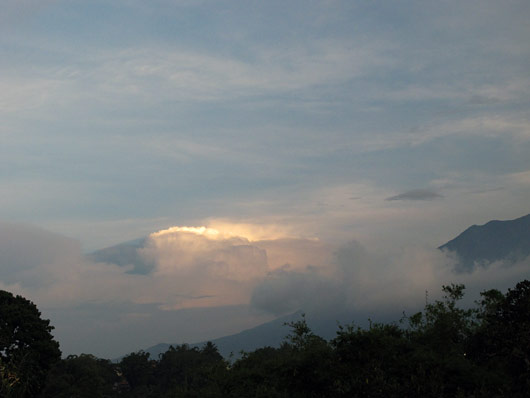
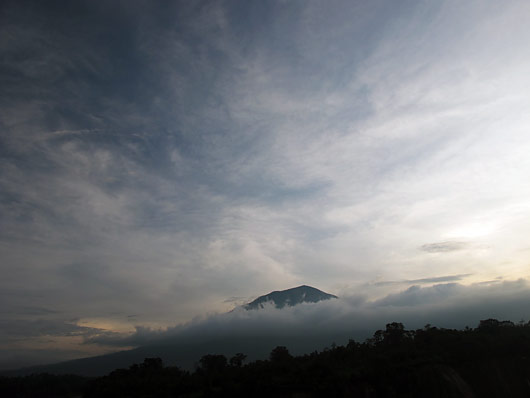
And a few moments later when the sun set:
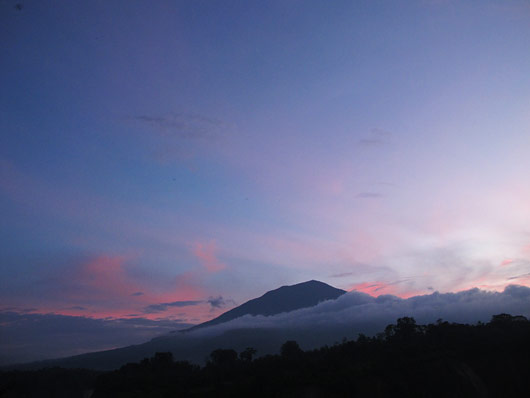
In Bukittinggi we also tried out a local speciality, tea and coffee with egg. Sounds disgusting, but we still wanted to try it, so we headed to some local stall. The cook seemed to be very surprised about the fact that we, tourists actually want to order it, so he asked if we were really sure. It did not add to our confidence, but since there were already a lot of people staring at us ("will they really…?"), backing out was not an option, so we said yes. The drinks were actually very good, and definitely filling. Here's a video about the preparation:
<object width="530" height="322"><param name="movie" value="http://www.youtube.com/v/UB5Usae99HQ&hl=en_US&fs=1"></param><param name="allowFullScreen" value="true"></param><param name="allowscriptaccess" value="always"></param><embed src="http://www.youtube.com/v/UB5Usae99HQ&hl=en_US&fs=1" type="application/x-shockwave-flash" width="530" height="322" allowscriptaccess="always" allowfullscreen="true"></embed></object>
There are two large lakes in Sumatra - lake Maninjau, situated in the West, and lake Toba, belonging to the northern part of the island - that may be considered the centres of two seemingly similar but still very distinct cultures.
The native people of West Sumatra are the Minangkabau (also called Minang or Padang people) who are best known for being the biggest matrilienal society in the world. However, while the property traditionally passes from mother to daughter, the religion and politics remain the domain of men - nowadays it is the Islam that rules the everyday life.
Learning is sonsidered important in Minangkabau culture, thus young boys leave their homes in an early age in order to become independent and come back home with useful knowledge. It is thought that this is the reason why only four million of the total population of seven million Minangkabau live in West Sumatra - the rest have gone to find their fortune mainly to other parts of the island, but also to Java, and even to Malaysia. This is probably why the Padang-style restaurants (where the food is displayed on the window) are so widespread all over Indonesia - Minangkabau people are known as good businessmen, and thus many of these young men who have left home have opened restaurants.
But in addition to Padang-style restaurants the Minangkabau are also known for their spectacular architecture which comprises finely decorated buffalo horn shaped roofs ("minang kabau" actually means a victorious buffalo). Unfortunately there are not too many original houses, built from the natural materials, left, but it is great to see that the traditions are kept alive in new, modern buildings.
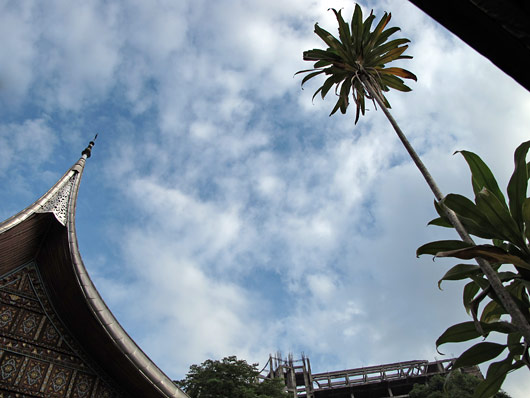
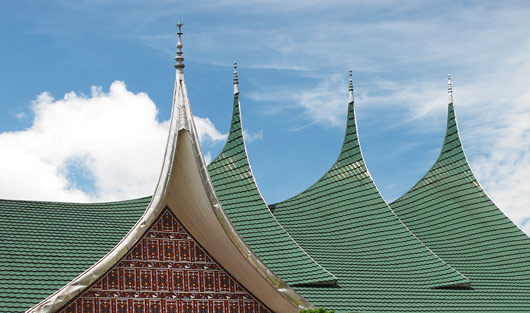
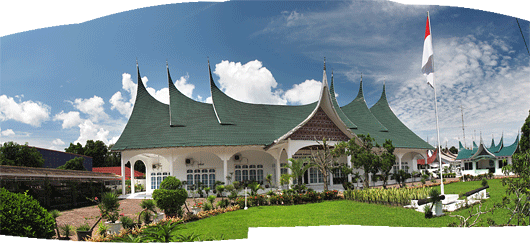
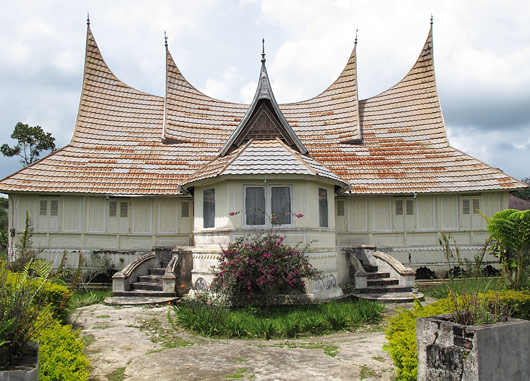
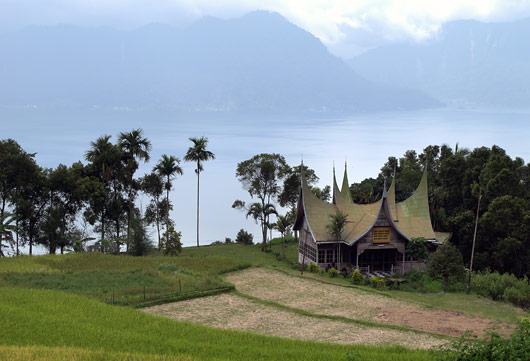
Sure enough, there is a legend associated with the buffalo horns. It says that a long time ago, Minang people had a disagreement with the prince of Java, but instead of starting a battle between the people they agreed to confront two buffalos. The prince of Java thought he was smart enough and chose a huge, agressive buffalo to represent him. The Minangkabau, however, chose to be represented by a calf. The trick was that before the decisive fight the calf had not been fed for days, and the night before its horns had been filed to be very sharp, so that when finally in the ring, the hungry calf thought that the big buffalo was its mother, so it ran underneath it to look for milk, and thus cut its stomach open with the sharp horns.
Lake Maninjau, located on the territory of the former Minangkabau kingdom, is a prefect place to relax and do nothing but to watch the clouds go up and down the crater walls, and the fishermen go back and forth with their dugout canoes. It is has it all to be a major tourist attraction, even the infrastructure, but at the time we were there, we were more or less the only tourists, so the unoccupied hotel and restaurant staff were more than happy to greet us. Maybe it's just the rainy season...


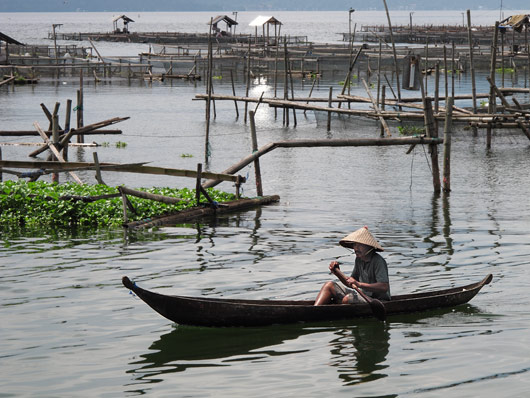
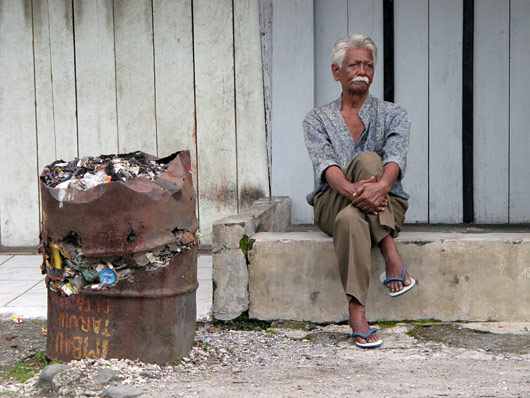
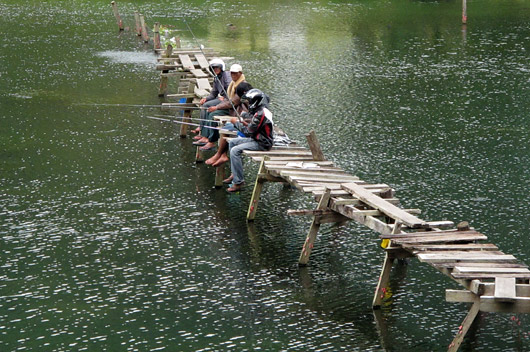
As you see from the picture above, some folk wear their helmets even when they go fishing. As funny as it looks, sometimes people even sit down for a lunch with the helmet on. One more thing worth mentioning is that bikers wear all sorts of helmets here, be it a baseball, construction or whatever else that categorizes as helmet.
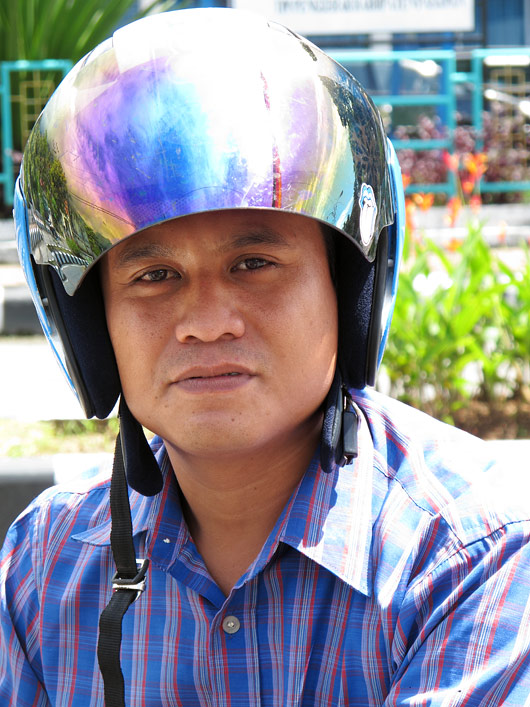
But back to the lake. We were really spoiled there by one small café which, in the beginning, did not look too promising with the very basic looking menu and slightly inflated prices. But just as it happens when you do not have any expectations, we were truly blown away by the taste and the quality of the food, making us return there again and again. The omelettes were heavenly and the chocolate-banana-coconut pancake was probably the best pancake we have ever tasted. But the top of the top was ikan panggang or Minang-style barbequed fish. There are no words to describe this dish, so you better get there yourselves! The best fish in Indonesia is served in Café Rama, Maninjau village right on the lake!

From lake Maninjau we headed north, and while we were staying in some random town's random hotel, we had a truly frightening experience. We were sitting on our bed, one of us editing the photos, the other writing notes, as we suddenly felt as if something had rammed the bed. A couple of seconds later we felt one more punch, much stronger and accompanied by loud bass, and heard the sound of a breaking glass and a woman screaming. Our first thought was to get out of the room, but nothing more happened. So we waited, legs shaking and heart racing, and wondered what should normally be done in such a situation. Nobody had taught us that because there are no earthquakes in Estonia. Sure enough, in the third wolrld country no hotel personnel would come to tell us that it was time to leave the building. It actually made us realise why so many people perish in earthquakes - there may be no warning and the initial "punch" may be so strong, forcing the building to collapse immediately. There is no way you can get out in such case, it really is a matter of seconds.
On the way north we passed through some jungle and saw some boiling hot springs. And even met a dog that curiously looked like a tiger!



(click to enlarge panorama)
And a recording from the same spot:
.::LISTEN::.

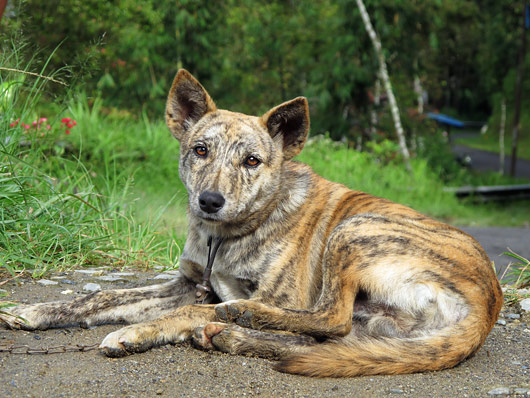
A mix between a tiger from a jungle and a dog?
But we also noticed a great number of Vespas. These are amazing machines, because most of them seem to be pretty old. But although they are really used and abused here (you would not imagine what sorts of stuff they transport here with Vespas), and many look like pure bred rat bikes - with paint falling off, broken details, rusted and bent - they still work. The locals say that these old Italian bastards are actually much more durable than the renowned Japanese products which can only take a couple of years' intensive use. But maybe it is also because many of those Japanese scooters used here (the most popular being Honda, Yamaha Suzuki and Kawasaki) are actually produced elsewhere, not in Japan. Interestingly we have not met here many Chinese scooters which are quite popular in South America.


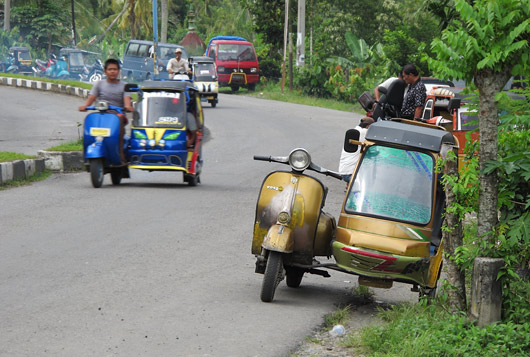
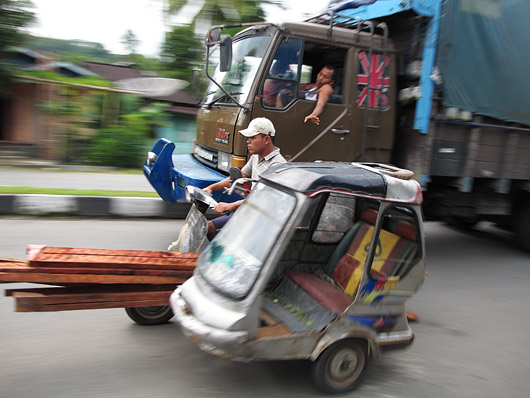
Crossing the equator was somewhat emotional, because most probably it was the last time for us to cross equator on this trip. With so many good memories, we said goodbye to the souhern hemisphere.
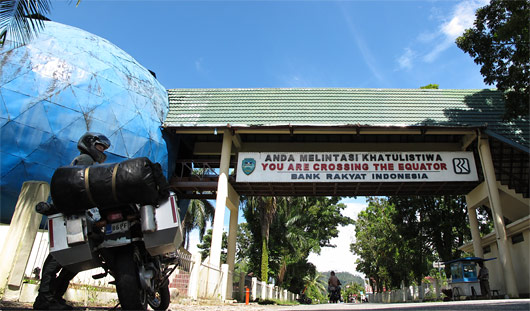
Pretty soon we entered the domain of a different people - the Batak. We could see it from the roofs - they still reminded us of buffalo horns, but not so elegantly drawn. The carvings on them, however left us a more dynamic impression.
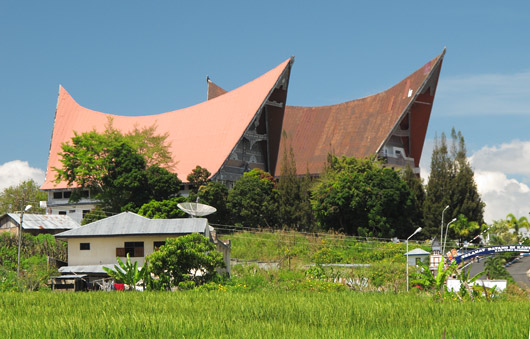

The first question that came to our minds, is of course, if these two cultures had common roots or if they had merged sometime in the past, but it does not appear so. Although visually so similar, there are fundamental differences. Firstly, the batak are patriarchal, and secondly, they are Christian. Frankly, the catholicism is ever present in and around lake Toba, with huge crosses and churches everywhere. On a Sunday afternoon one can see many nicely dressed people going to and coming from church. Interestingly, the people speak more readily English here - the missionaries must have done a great job! That said, it is interesting to point out that only two centuries ago the Batak people practiced cannibalism, i.e. ate flesh of their enemies and those condemned in serious crimes. And that one of the theories considering the origins of the term "Batak" says that in Malay language it signifies a robber or a blackmailer! It is, of course, just one of the theories...
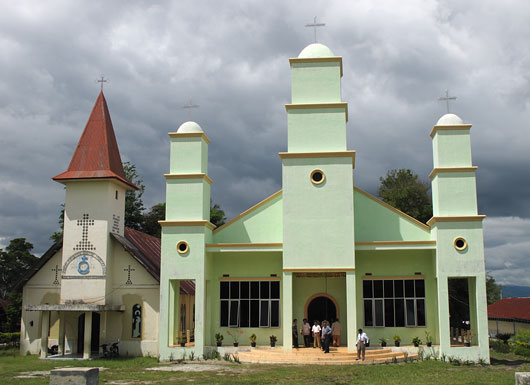

So, as said before, the majority of the Batak's 6-million population (of whome 5 millions in North Sumatra) is concentrated in lake Toba region, so in order to get better acquainted with yet another fascinating culture, we decided to go to the Samosir island in the middle of the lake. To do that we had to take a ferry, and in the harbour there was a bunch of naked kids running around. For them, we ("white people with a huge bike") surely were amusing, and they were trying to show off every way they could. They would keep jumping off board even when the ferry had already left the dock.
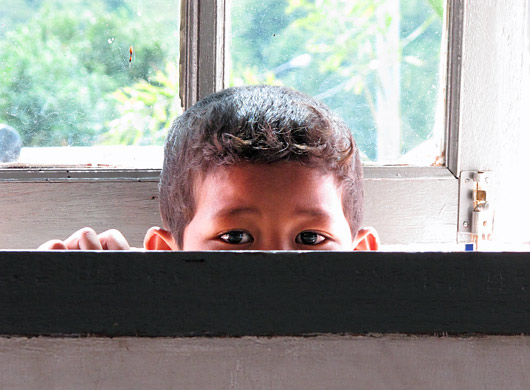

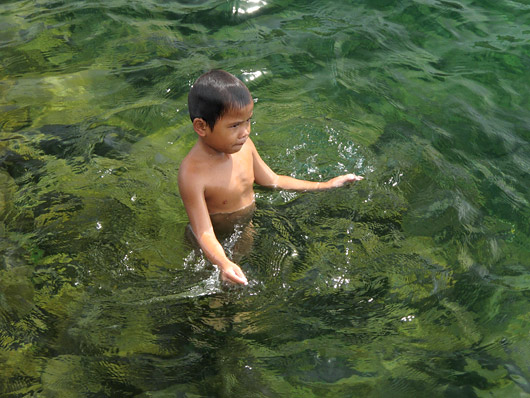
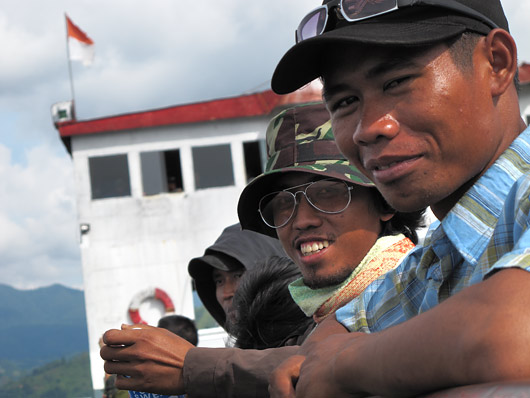
The first impression of the island was pretty spooky as it was full of deserted, if abandoned hotels. In the nineties it used to be the gathering place for the full moon ravers, but now they have all fled to Thailand and the tourism has gone down significantly, leaving most of the Batak-style roofed hotels empty. Maybe its is also the rainy season to blame, but it does create a sense of melancholy. There are a handful more tourists, but it is still delightfully quiet and empty, and one can have the beach to itself.

But what we came to Samosir island for was not the beach nor the empty hotels, but the culture, end we experienced plenty of it. There were loads of traditional houses and when we made a half-circle of the island, reaching even the more isolated places we could actually see whole villages consisting of Batak-style buildings only. The ride was in places extremely rough, with many sections of the road (which was rather a track) under water, or just very rocky. But It is amazing to see that people actually do still live the old way, although I bet if they had more money they would build themselves a modern, more functional (but boring) home.
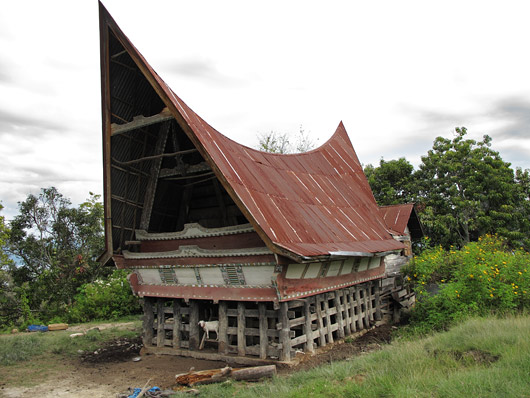
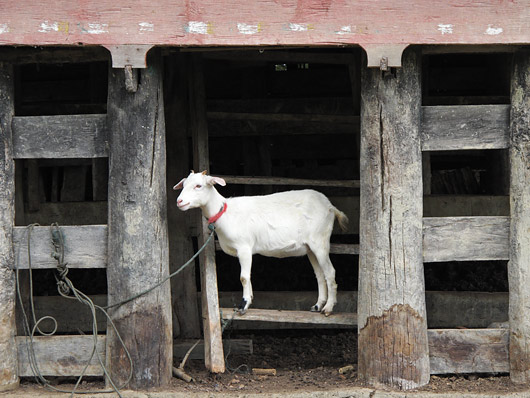
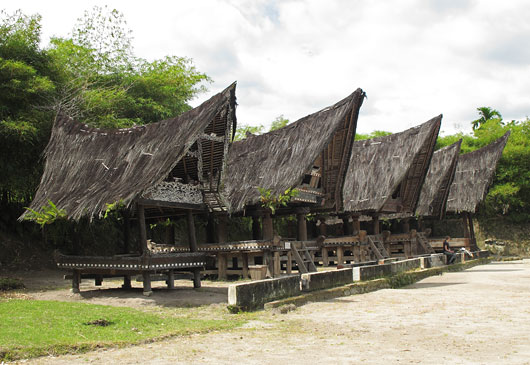
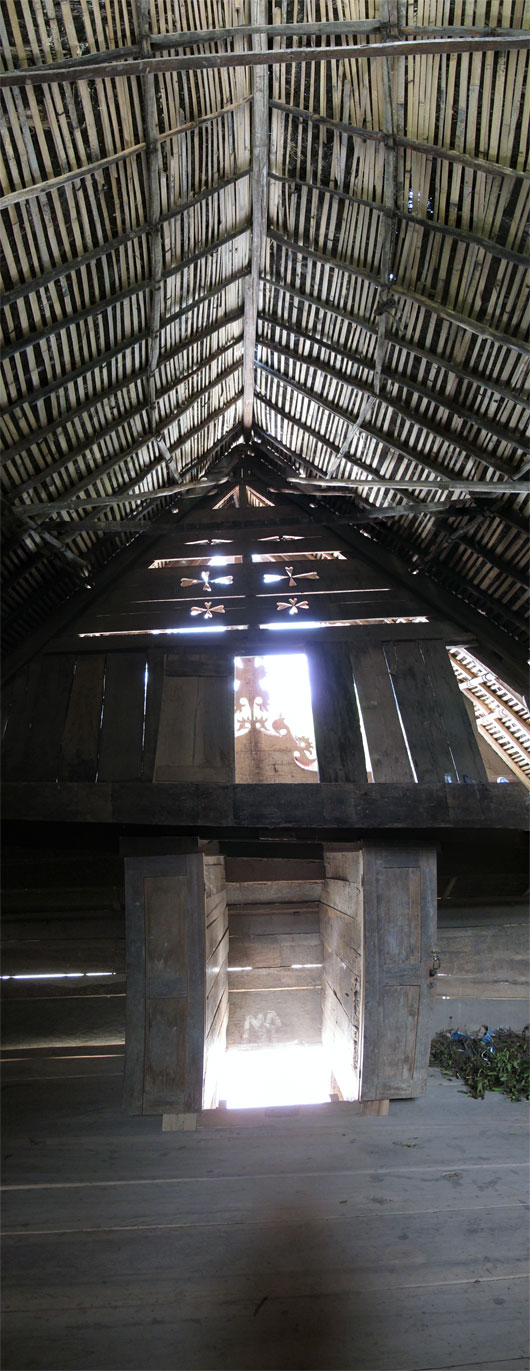




A lighthouse in batak style.
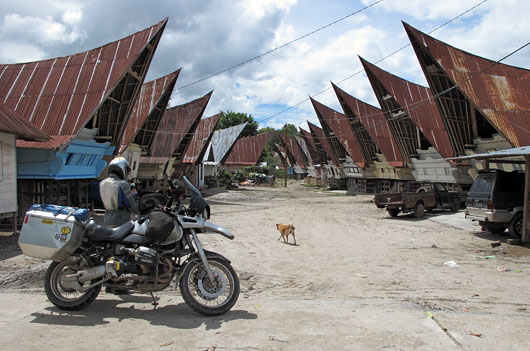
Traditional batak village - GS was like a space ship that just arrived - soon it was circled by all the village.

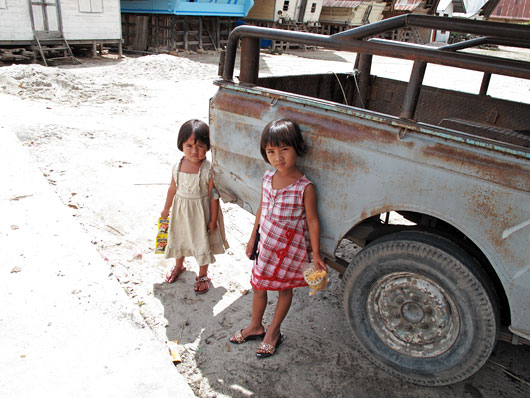
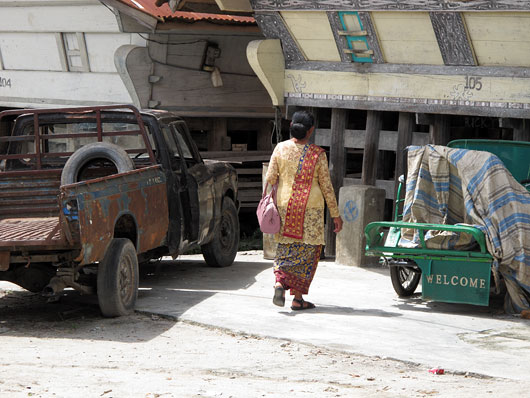
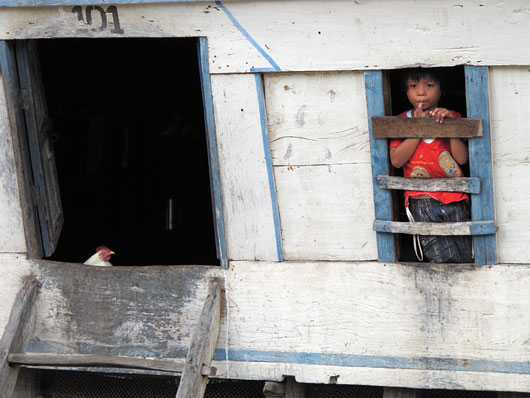
We also went to see a Batak dance show. Their music is not too dynamical but the beat is captivating!
.::LISTEN::.
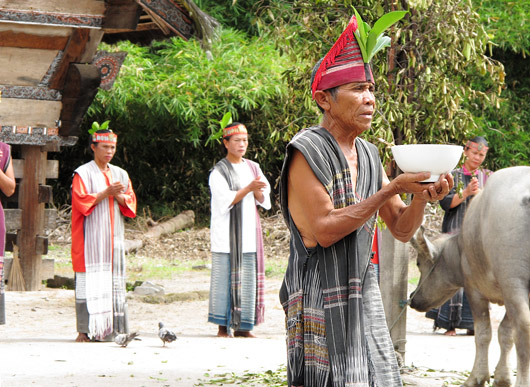
Batak dance.

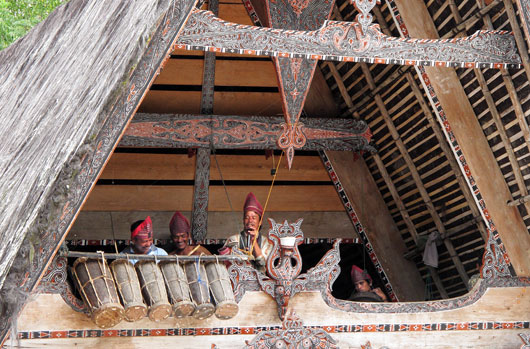

Batak drums are integrated into the building - wooden building acts as a sound aplifier!
When we had enough of the cultural experiences Kariina decided to take an Indonesian cooking class - after all, our time in Indonesia was about to be over soon, but we definitely had acquired a taste for some of the local dishes, so this was the last chance to learn to do it at home. She was amazed at all the tools and spices used in the local cooking. Did you know, for example, how a coconut is grated? A funny appliance and a lot of force is used:


Or to squash herbs and spices? With robust black rock and it's strong rocky base plate!
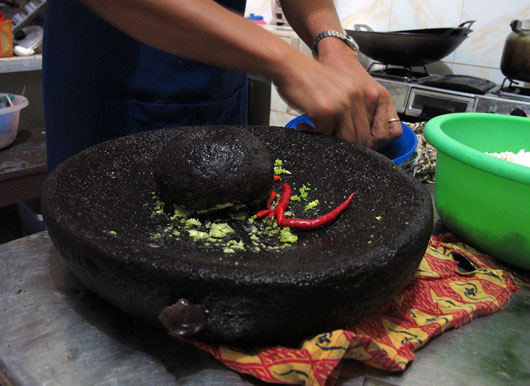
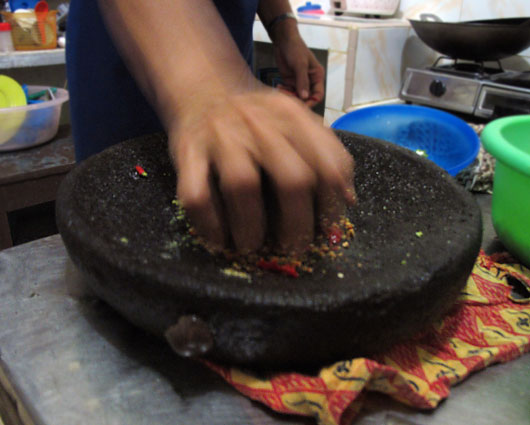

Wok-pan is the tool of choice.
The result of a half-day cooking class was a tasty set of four dishes: urap (vegetables with coconut), fish curry, chicken rendang and fried bananas.



Some geckoes were watching us from the ceiling as we were feasting on the freshly cooked food. Those creatures are very common here, notably at night when the lights attract mosquitoes, their favourite grub.


After lake Toba we headed to Bukit Lawang to see some orangutans, the largest arboreal mammals in the world. There are not too many left of them, and Sumatra is one of the rare places where you can see one in the wild. We hired a guide and went trekking in the jungle. And it was a sporty undertaking, we must say, involving lots of climbing up and down the steep, muddy slopes.




You can swing naturally in the jungle, like a Tarzan.


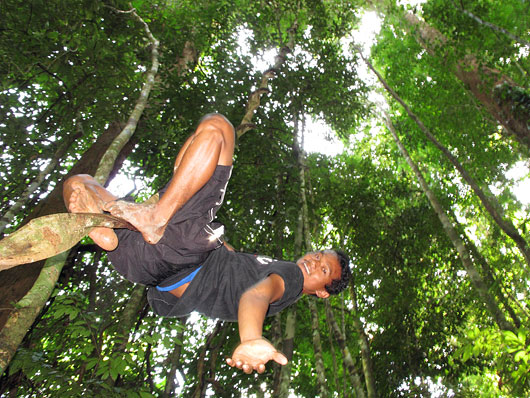
Our guide demonstrated how to climb and use that hanging stuff for the "convenient" transport in the jungle.
We also saw a lot of monkeys, and of course the huge red-haired orangutans. They really look incredible, pretty human and intelligent. Unfortunately, they are thought to become extinct in 10 to 15 years.

Gibbons.
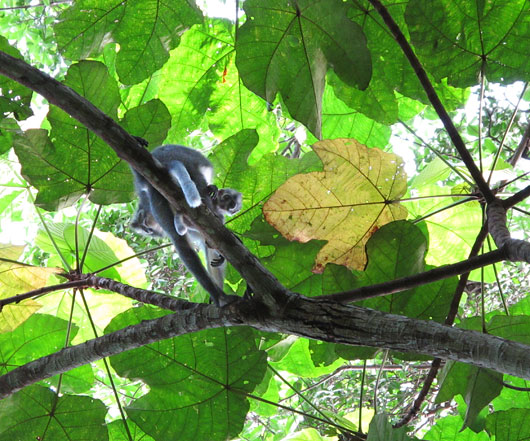
A Gibbon mother with a baby staring down at us.
The sound Gibbons make in the jungle:
.::LISTEN::.
All sorts of bugs were there as well, from spiders to leeches. A couple of them had gotten through my socks and squashed, leaving blood stains. Not so nice!

Jungle spider.

A BIG ant!

Leech bites bleed a long time:


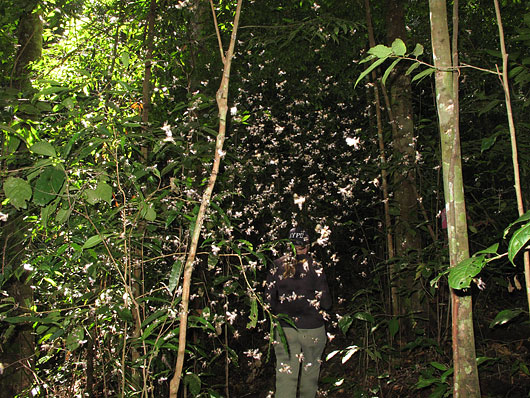
Flying bugs in the jungle.
A strange bug making curious sound in the jungle:
.::LISTEN::.
Here's a video about our trek through the jungle in Bukit Lawang:
<object width="560" height="340"><param name="movie" value="http://www.youtube.com/v/rKNVlHGQj_s&hl=en_US&fs=1&"></param><param name="allowFullScreen" value="true"></param><param name="allowscriptaccess" value="always"></param><embed src="http://www.youtube.com/v/rKNVlHGQj_s&hl=en_US&fs=1&" type="application/x-shockwave-flash" allowscriptaccess="always" allowfullscreen="true" width="560" height="340"></embed></object>
Here's a small ride video around Samosir island. Mostly we're two up, but sometimes Kariina filmed riding on some easier spots:
<object width="560" height="340"><param name="movie" value="http://www.youtube.com/v/XDqmef_mFCI&hl=en_US&fs=1&"></param><param name="allowFullScreen" value="true"></param><param name="allowscriptaccess" value="always"></param><embed src="http://www.youtube.com/v/XDqmef_mFCI&hl=en_US&fs=1&" type="application/x-shockwave-flash" allowscriptaccess="always" allowfullscreen="true" width="560" height="340"></embed></object>
It turned out no cargo ships are working between Indonesia and Malaysia during Christmas holidays. Which, of course, makes you think why the world's biggest muslim country called Indonesia gives a toss about christian holidays? Seems they do, good excuse to have a free days off work!
We found it out while chatting with the guys at the transport company in Belawan. We were slightly dissapointed to say the least. Didn't expect this and did not know what to do with our time now and our VISAs starting to expire. It started to rain so we waited in melancholy in front of the transport company's door. But things were turned around when locals delivered us free rice meals and drinks and we had good time chatting with them till the rain stopped. Loads of people gathered around and looks like their day was made meeting white foreigners on a monster sized motorcycle, even a local journalist writing for "Koran Radar" was there. :lol3

Back in Medan we phoned Kantony whom we had met in Padang a couple of weeks before and who insisted that he pay for our hotel room (which we thought was a bit too expensive and we were about to leave in search for another hotel). We kept our promise to call him once we are in Medan and that is what we did. As a result, we had a nice Christmas dinner with him (and his wife and daughter and friend), and for the first time in our life we had a chance to try a crab. We really felt sorry for the poor creature though!



So we had to spend Christmas waiting till the cargo ships start working again - the small Batak town of Berastagi was a good option to make up our time.
Located between various volcanoes, the town itself isn't some wonder, but decent enough to kill our time taking photos and visiting the local smelly but decent market that had tropical fruits we never had seen/tried before:


Looks like a cucumber, tastes almost the same.

Passion fruit.

Mangosteen - a superb tasting fruit!

Muddy-smelly market.

Half-alive fish for sale.

Snake-like fish.
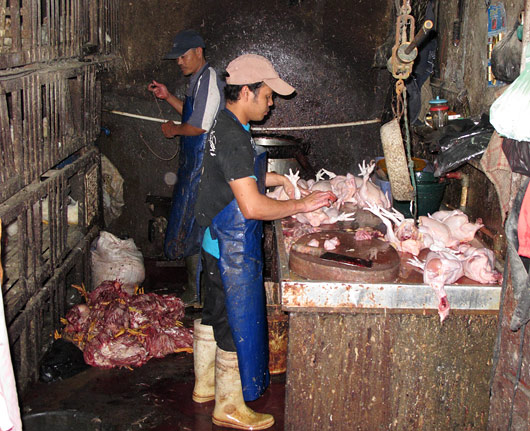
One kills, other cleans the chicken - a quick process in "very clean and sterile" conditions!

Nothing is wasted! Everything goes for sale.
Some pics from the market:



Mountains of black pepper.
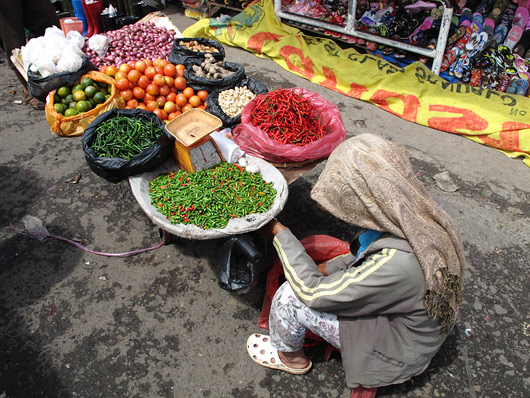
You can basically kill yourself with eating unlimited amounts chilli in most of the foods in Indonesia! Indonesians DO have iron-stomaches!!!
From Berastagi we rode to the local village of Lingga, which hosts a different Batak tribe called Karo Batak. They also have a unique architectural fingerprint:


(click to enlarge the panorama)
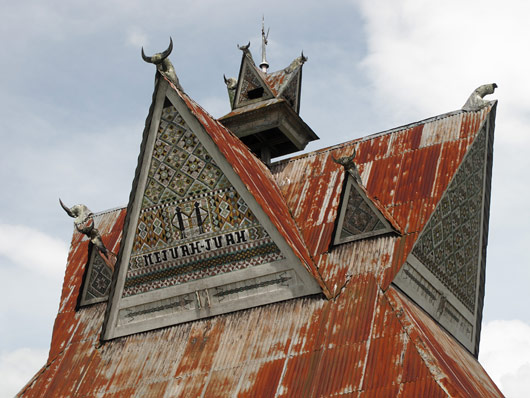
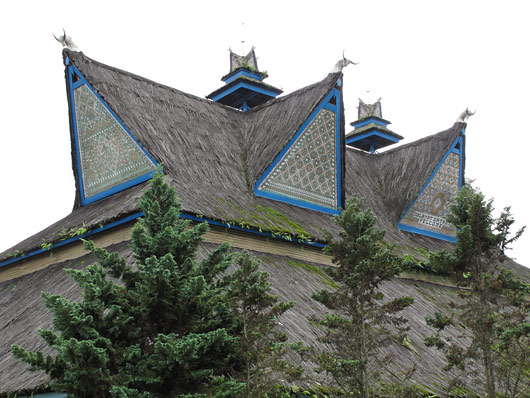
And of course, everything is used for transportation:



Curious local boys.
The rest of Lingga:

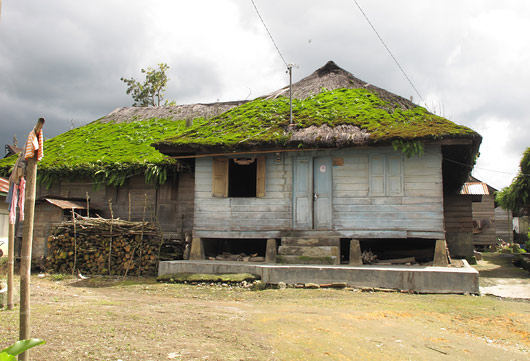
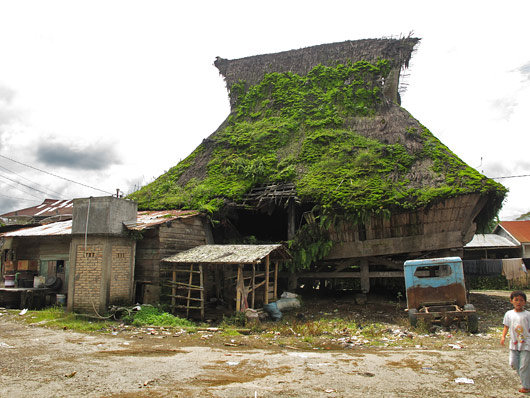

Different Karo Batak style churches:
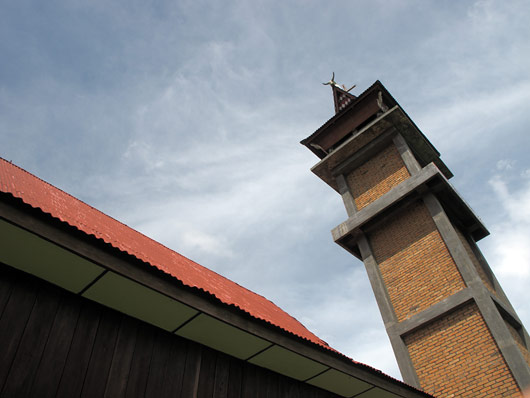
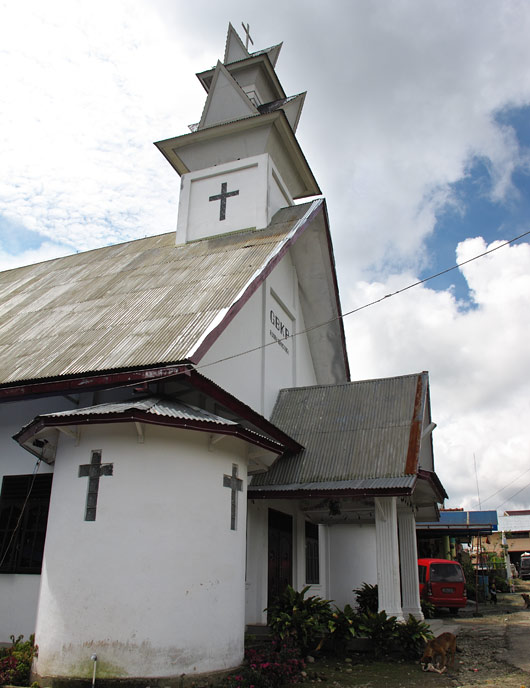

Tropical rain cut our visit to Lingga short and we soon headed back to Berastagi, which was, compared to rural Lingga, like a brick jungle:
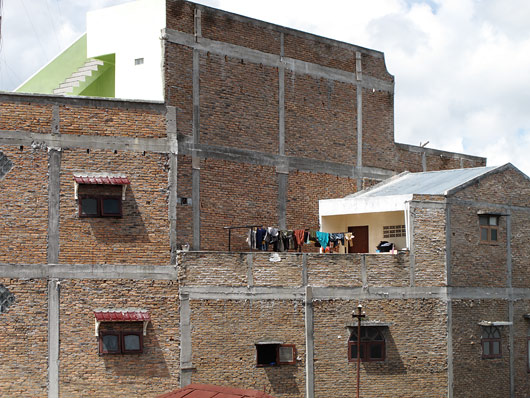
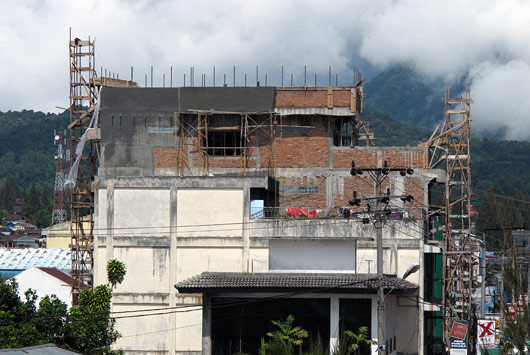

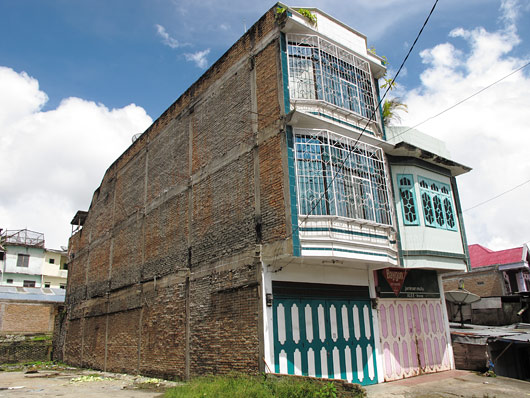
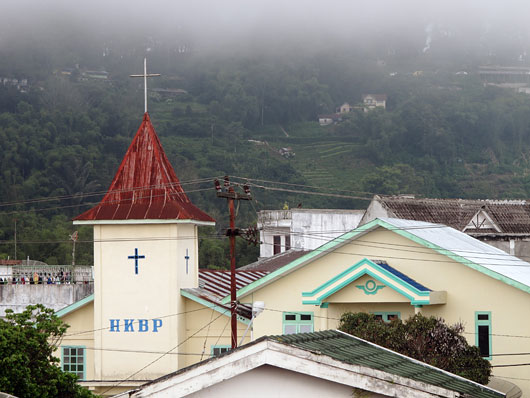


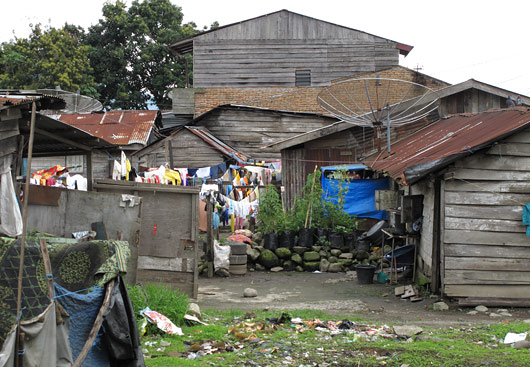
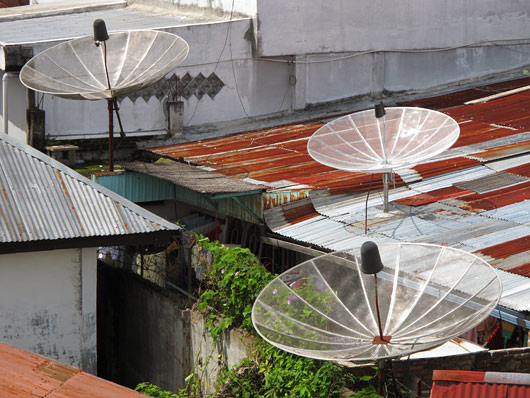
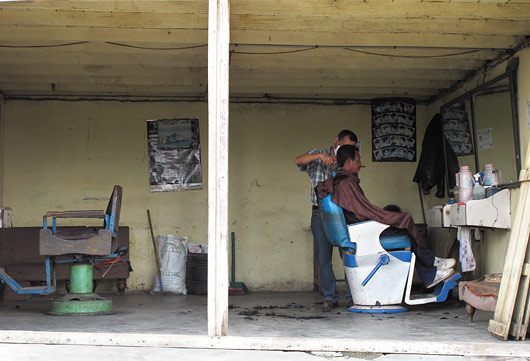
Hairdresser's place.
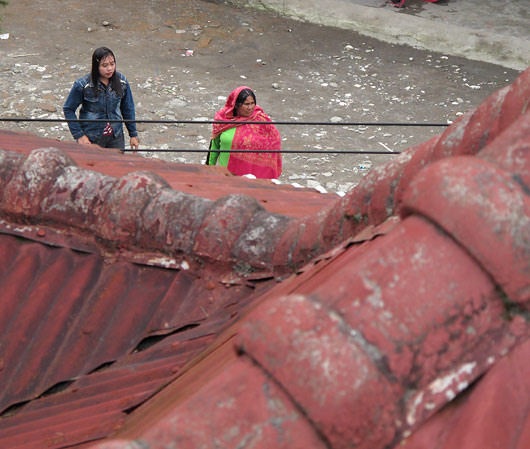
And there our new year came. We bought a small locally made mini-cake, with "Welcome, new year!" written on it:

Unlike western people, Indonesians don't have zillion dollars/euros to throw into the sky with fireworks, so their version of the new year's big bang was of course more controlled-budget and humble compared to anything in the rich West, but at least we got a mystic moon surrounded with halo for the new year!
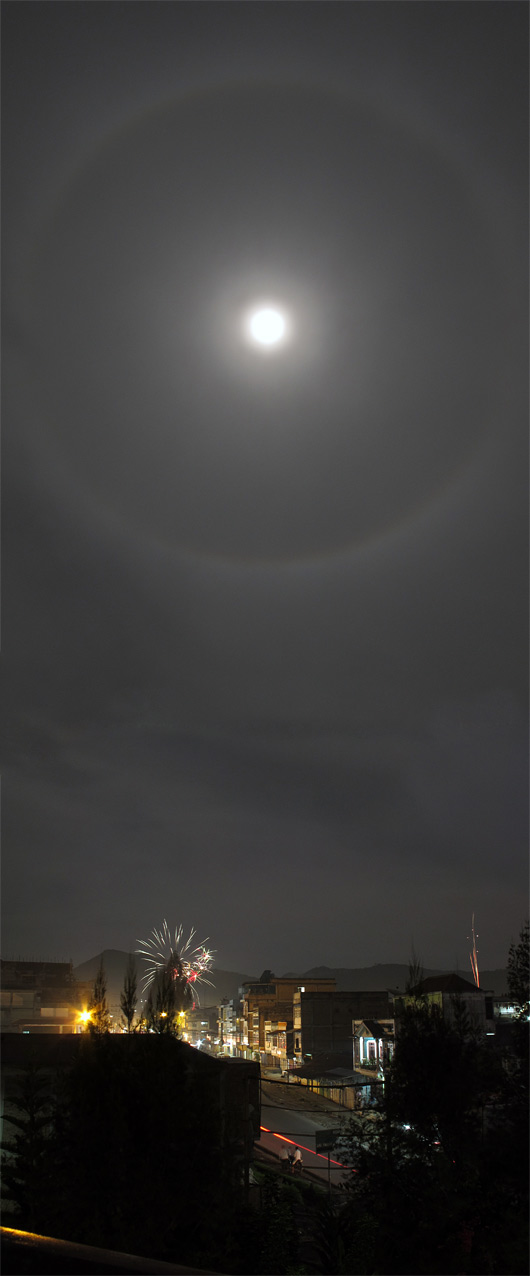
Happy new year to everybody!
Route:
<iframe width='600' height='480px' scrolling='no' frameborder='0' src='http://www.geoape.com/embeded/yhelteljelee-indoneesia-1593'></iframe>
We spotted a Hindu funeral while in Bali:
<object width="560" height="340"><param name="movie" value="http://www.youtube.com/v/JUjRYwpCLBA&hl=en_US&fs=1&"></param><param name="allowFullScreen" value="true"></param><param name="allowscriptaccess" value="always"></param><embed src="http://www.youtube.com/v/JUjRYwpCLBA&hl=en_US&fs=1&" type="application/x-shockwave-flash" allowscriptaccess="always" allowfullscreen="true" width="560" height="340"></embed></object>
They do it in a VERY different way compared to the western people who mourn, cry, sad faces, sad music, etc etc...
For Hindus death is just a path of endless life cycle. Soul leaves your body, your body will be given to space and your soul will reincarnate. But for Hindus it is VERY important that the soul doesn't find its way back into the old body, if it does, it'll echo and haunt. That's why during the funeral ceremony they shake and rotate the coffin to confuse the soul, so the soul doesn't find its way back into the old body and can find its way into a new life.
As you can see from the video Hindus play very interesting positive music for that occasion - people have no drama like in islam/christianity - they were rather cheerful and for them it was even some level of fun shaking the coffin!
Instead of just a couple of days we ended up staying in Lovina, Bali, for a whole week. Bali and its Hindu culture is not something that strikes from the moment you arrive, but it is just so relaxed and so beautiful, like a spell, that just does not let go of you. So we chilled out and for the first time had something that one could call a vacation on/from the trip. We went dolphin watching, snorkelling, bathing in hot springs and, of course, sightseeing.
There is a Buddhist monastery in the nearby village, Banjar. Exactly, Buddhist, not Hindu. It is amazing how two different religions can exist peacefully side by side. It was a calm and relaxing place with nice views and lots of sculptures.








After a bit more than a week on Bali it was time to say goodbye to the sweet Balinese, and move onto the next island - Java.


It is interesting to note that Java is one of the most densely populated regions on Earth, with the population density of some 1000 people per square kilometer. Considering that, we were pleasantly surprised to find the eastern part of the island relatively calm and airy. One of the first sights was Gunung Bromo, a volcano which is also considered one of the most breathtaking places in Indonesia. And to be honest, it was pretty magical.
We were lucky enough to arrive there on a sunny day while it is actually the rainy season here, in Indonesia. In the national park there were only a handful of tourists, so the place looked empty and even somewhat desolated, as if the time had stopped. Only the clouds were making their way up and down the collapsed caldera, and a couple of horsemen were there trying to sell us a ride up the slope of Bromo.

The crater base consists of grey coloured sand, so to get to the volcano we had to struggle a bit with our heavy bike, while the locals were whizzing by on their small bikes like flies.



But we made it there, and we could take a peek into the smoking crater itself. It truly was an astonishing experience, to see (and smell) all that smoke and to hear it roar as it makes its way up through the Earth core.





You can see Bromo and our riding around the area from the video below.
<object width="530" height="323"><param name="movie" value="http://www.youtube.com/v/wbvA_22TcF4&hl=en_US&fs=1"></param><param name="allowFullScreen" value="true"></param><param name="allowscriptaccess" value="always"></param><embed src="http://www.youtube.com/v/wbvA_22TcF4&hl=en_US&fs=1" type="application/x-shockwave-flash" width="530" height="323" allowscriptaccess="always" allowfullscreen="true"></embed></object>
As a background, we used a tune performed by a gamelan orchestra. Gamelan is something specific to this region (mostly Bali and Java). The term itselt does not refer to the group of people playing the music, but to the set of instruments, which have all been tuned to that specific set and are thus not interchangeable. They even say that there are as many different tonal scales as there are gamelans.
But there is more to Java than the volcanoes. Once again, since so many people live on the island, you can see traces of human action everywhere. We found the most stunning the sleepy mountain villages featuring modest houses and masterfully cultivated land - it is difficult to imagine the steep slopes that sustain agriculture (not only rice, but also potatoes and cabbages) here. The people are much more relaxed and don't come running to you with the endless "hello misterrrr!".










One of the coolest (literally!) experiences was the Dieng plateau, famed for its high altitude and steaming crater lakes. And cool it was - the hotel (rather a homestay) even provided us with two blankets and a termos with hot tea. It is weird how in the morning you can sweat like hell at the lower altitudes, but once you get to 2000 and up, it becomes so cool that you can even see your breath.




Dieng is a small village, but there are still at least four mosques. So on many occasions one can hear examples of koran recital.
.::LISTEN::.
One of these did not sound too good. Our first thought was that maybe a drunk imam had grabbed the microphone, but the Muslims do not consume alcohol, so maybe it was the faulty sound system:
.::LISTEN::.
So that's about the modest sightings. As you can see, modern Indonesia is truly Muslim these days, but it has not always been the case. There are things here that Indonesia is more famous for, and these are the Hindu and Buddhist temples of Prambanan and Borobudur, respectively. They were built in around the 9th century, and are funnily located so close to each other (maybe some 50 kilometres away, as the crow flies) that it once again makes you wonder how they could get along so well.
Prambanan's centerpiece is the platform containing huge temples for the main Hindu deities - Brahma, Shiva and Vishnu. Unfortunately, at the time of our visit many of them were under reconstruction (they were badly damaged by and eathquake a couple of years ago) and thus we are not entirely sure if they are really worth the 11 USD entrance fee applied to foreigners.

Borobudur left us a better impression - it just looked cool and contained a wealth of intricate stone carvings. But it was crowded with tourists, many of them locals (who actually pay some ten times less than foreigners), climbing on the precious statues to pose for a Facebook picture and sticking their hands in the bell structures atop the temple to touch the Buddha statues inside them. It felt as if we were in a zoo. I do not know if the temple itself is considered sacred, but something should be done if we want this World Heritage listed site to remain intact.





As we reached central Java, the population grew denser, and the traffic just became mad. It is not chaotic, not at all, it is just that different rules apply here that contradict the rules we have been tought. One of them is related to overtaking. According to our experience (observing others), overtaking is allowed (or even better, expected) even if there is someone already overtaking you, in front of you, or if there is someone coming in your direction. Normally it all works out fine (after all, so far we have not seen any accidents except for a couple of trucks driven off the road), but one has to beware of the buses, because what counts here is your size - pure physics - so if you see a bus coming towards you, do not expect it to change lanes. It will flash lights or beep the horn, and you will have no other choice but to get the hell of the road and out of its way! So, yes, the traffic is dense here, and it must be the worst we have ever seen.
Through some hundred kilometres we finally arrived in Jakarta, the Indonesian capital. So if Java is considered to be the heart of the Indonesian nation, Jakarta must be the very center of it. The first thing we noticed was of course the mandatory skyscrapers, some of them pretty nicely designed.








But below them modern monsters, life works at a different pace, interlaced with religion and bound by other rules. There are mosques and prayer rooms everywhere, starting with gas stations and shopping malls, and ending with hotels. This is how a prayer room looked like in our hotel.

Beneath the skyscrapers people live their simple everyday life, wearing flip-flops (even when riding a bike) and smoking a hell lot of cigarettes.


There are lots of cats running around on the street, and the architecture is interesting, but reflects the poverty.




One thing that caught our attention is that although we sometimes look towards Asian countries as the big consumers and pollutants of the future, today's Indonesian's ecological footprint is for sure smaller than ours, although we pretend to be environmentally aware and so on. They do not use electricity to dry their clothes (rather, they hang it on a rope or place it on rocks so that the sun would dry them), and availability of fresh juices reduces the quantity of plastic packaging. They use a scoop to wash down the toilet and to wash themselves, thus reducing fresh water consumption. Of course, it is not because of their awareness - mostly it is due to the economical and cultural background, but still!


One of the highlights for us when visiting Jakarta was meeting a local biker (an ADVrider!) Bram and his wife Griska. When they came to meet us in our hotel, they brought us two jackets with the emblem of a local biking forum, some food that Bram had cooked himself (we had expressed or scepticism about being able to reach his Chinese food restaurant located in the suburbs, so...), and Griska even had a special gift (local style accessories) for Kariina. It was all totally unexpected, because normally it is the guests who bring the gifts. We were even more stunned when Bram took out a sheet of paper which had 28 questions related to our trip. He really is dreaming of doing it himself, so we were extremely glad we could share our experience.


Our last couple of days in Jakarta were rainy (it is rainy season after all).


And the morning we left Jakarta we were woken up (once again) by koran recital, at 4 AM. But it sounded so good that although my body was still asleep, my mind seemed to be so clear as if it had been some sort of spiritual enlightenment. Being there, of course, gave a powerful impression as the city was slowly waking up and the morning fog was rising from the streets with deep blue clear sky above...
.::LISTEN::.
So we left Java, taking a ferry (for the last time in our Indonesian island hopping) to Sumatra. As we were leaving the port we could see (too) many rustbuckets standing waitning for their turn there. Really, no surprise that so many of them sink.


One young guy caught our attention by trying to swim first next to, and later after the ferry as it was leavig the port - a dangerous thing to do, considering that boats have propellers both in the rear and on the sides (for manouvering in the port). But someone threw him a banknote, so he swam away with it.

The crossing was smooth, and the elements of an Indonesian boat ride were all there, meaning the loud Indonesian pop music coming from the pirated CD store set up on the car deck, and surely lots of people wanting to get acquainted with our bike.
.::LISTEN::.





Finally we arrived on Sumatra which is four times the size of Java, and just a quarter of its population. It sounded like a promising fact, at least we imagined there would be less traffic and more air lo breathe.
And that is exactly what our first impression was. Sure enough there were the shimmering rice paddies and sleepy villages that we had already seen before, but somehow the overall atmosphere was much more relaxed, yet more impressive.






The air was in fact so fresh that after the madness and congestion (that always comes hand in hand with dizzying exhaust fumes) of Java, and especially of Jakarta, it felt as if we had stepped into another world. We spent our first night on Sumatra in a small town of Kalianda where we probably were the only foreign tourists, and it greeted us in a majestic way, with a thunderstorm, perhaps reminding us that here, more than in many places in the World, life is reigned by the forces of nature.



The following days proved us that this island, which has not been frequented by foreign touristed too much after the 2004 tsunami which devastated Banda Aceh in the north, is a true chocolate box. Since we did not have a map, we decided to take random roads leading north, and this is how we ended up riding up the west coast, passig by (once again) picturesque fishing villages.







Click to enlarge panoramas:


Once we stopped by the road, amidst some coffee plantation, to taste the durian, a famous fruit that the locals love but which is often resented by foreigners. Well, it sure has a strong smell (quite good actually), but the inside is somewhat spooky, visually reminding of rotten eggs. Let's say that if you ignore those associations, it is not bad, but it did not necessarily leave us craving for more.






A thing that appealed to us the most at that roadside stop was the weird sound some bugs were making in the bush, which reminded of tehcno or electro music.
.::LISTEN::.
One day, by late afternoon we stopped in a random village, and as we set off to look for some bakso - a soup most often served by street stalls, we first ended up buying some deep fried bananas from a similar looking stall.


We continued our quest through the village, and at some point we heard some music. Soon enough we were invited by some local ladies to join their band, but after they had performed us a tune or two, they asked in a shy way if they could take a picture with us. Our positive answer was followed by a half-an-hour photo session and lots of giggling. We sure looked weird to them, as we are much taller than the locals, and we do not speak much Indonesian. Luckily, one of the ladies was an English teacher at the local school.
Here is their music:
.::LISTEN::.
And here are the results of the photo session:






Luckily, after so many deviations, we could find a place that served bakso.

Before we reached the centre of Sumatra we passed through some more wonderful scenery - rustic villages, rice paddies, nice beaches and lush jungle, and we really could not be but in love with this island.

(A brick factory in Indonesian style - they burn the bricks under specially built building)




Typical coastal village street.

A restaurant in one of the villages.


Sumatran coast (click to enlarge the pics and panoramas)













Night fishing armada at the port - click on the pic to see how many lights each boat has!
Caught fish:


The fauna was amazing as well. We could see many species we had never seen before, and one of the highlights was saving an interesting looking turtle from being killed on the road.




Click to see small crabs in detail:



And a tiger warning sign on jungle areas we rode through:



While in the jungle area, we heard some funny noise, and recorded it. First we thought it was monkeys, but might also have been some birds:
.::LISTEN::.
The people were ever welcoming and curious about our bike. In fact, their curiosity is never agressive - normally they will gather around you and just stare at you, not intruding into your precious personal space. Its is after you make the first attempt to communicate with them, they will become very lively and ask a hundred of questions about you and your bike. Some of them, though, will not want their pictures to be taken. The children, of course, are not so reserved, but ready to pose for a picture whenever you take out your camera.





Everywhere we stopped, local crowd started to gather around our GS for a "close inspection" - most of the people hadn't seen such a big bike in their life (their local bikes are all scooters around 50-150cc):


In the centre of the island we were greeted by Padang, the biggest city on Sumatra's west coast. The first thing that struck was the abundance of buildings that are about to collapse. Later we heard that there was an earthquake just a couple of months ago.


But more than looking at those ghostly buildings we enjoyed a visit to the harbour which is home to a great number of (surprise-surprise!) rusty boats, which obviously does not stop them from going to sea. The work was going on, so they won't be retiring too soon either.

(click to enlarge pics and panoramas)




It was also nice to walk along the promenade, and to see local fishermen pulling their nets out of the waves, and selling their fresh catch. Some local folk were very eager to chat with us, so we also had a bit of a cultural exchange.








Bukittinggi, some 930 meters above sea level, is the main tourist town of the area. Sure it is situated between three volcanoes, and sure it is a great base for tours and treks in the nearby area, but what's so special about the town itself? It took some time to figure it out, but we did. It has a lively market selling lots of colourful stuff from fuits and veggies to dried fish and produce we could not identify.







We also tried some local fruit that from the distance looked like small potato, but the taste of which actually reminded us of rambutan which we really like. It is called longkong.


Walking back to our hotel we met some interesting looking people.

A singing blind beggar.

Another blind woman begging on Bukittinggi street.
Local people were very warm:



Some ride around on stylish retro Vespas.
Locals wanted to pose with the big bike and white skinned tourists:


And they were slightly dissapointed when I said I'm married.
We spent the night wandering around in Bukittinggi's panorama park which offered nice views of the nearby Sianok canyon and of the volcanoes. We also met a monkey, and a young muslim couple.



Views from the city park:


And a few moments later when the sun set:

In Bukittinggi we also tried out a local speciality, tea and coffee with egg. Sounds disgusting, but we still wanted to try it, so we headed to some local stall. The cook seemed to be very surprised about the fact that we, tourists actually want to order it, so he asked if we were really sure. It did not add to our confidence, but since there were already a lot of people staring at us ("will they really…?"), backing out was not an option, so we said yes. The drinks were actually very good, and definitely filling. Here's a video about the preparation:
<object width="530" height="322"><param name="movie" value="http://www.youtube.com/v/UB5Usae99HQ&hl=en_US&fs=1"></param><param name="allowFullScreen" value="true"></param><param name="allowscriptaccess" value="always"></param><embed src="http://www.youtube.com/v/UB5Usae99HQ&hl=en_US&fs=1" type="application/x-shockwave-flash" width="530" height="322" allowscriptaccess="always" allowfullscreen="true"></embed></object>
There are two large lakes in Sumatra - lake Maninjau, situated in the West, and lake Toba, belonging to the northern part of the island - that may be considered the centres of two seemingly similar but still very distinct cultures.
The native people of West Sumatra are the Minangkabau (also called Minang or Padang people) who are best known for being the biggest matrilienal society in the world. However, while the property traditionally passes from mother to daughter, the religion and politics remain the domain of men - nowadays it is the Islam that rules the everyday life.
Learning is sonsidered important in Minangkabau culture, thus young boys leave their homes in an early age in order to become independent and come back home with useful knowledge. It is thought that this is the reason why only four million of the total population of seven million Minangkabau live in West Sumatra - the rest have gone to find their fortune mainly to other parts of the island, but also to Java, and even to Malaysia. This is probably why the Padang-style restaurants (where the food is displayed on the window) are so widespread all over Indonesia - Minangkabau people are known as good businessmen, and thus many of these young men who have left home have opened restaurants.
But in addition to Padang-style restaurants the Minangkabau are also known for their spectacular architecture which comprises finely decorated buffalo horn shaped roofs ("minang kabau" actually means a victorious buffalo). Unfortunately there are not too many original houses, built from the natural materials, left, but it is great to see that the traditions are kept alive in new, modern buildings.





Sure enough, there is a legend associated with the buffalo horns. It says that a long time ago, Minang people had a disagreement with the prince of Java, but instead of starting a battle between the people they agreed to confront two buffalos. The prince of Java thought he was smart enough and chose a huge, agressive buffalo to represent him. The Minangkabau, however, chose to be represented by a calf. The trick was that before the decisive fight the calf had not been fed for days, and the night before its horns had been filed to be very sharp, so that when finally in the ring, the hungry calf thought that the big buffalo was its mother, so it ran underneath it to look for milk, and thus cut its stomach open with the sharp horns.
Lake Maninjau, located on the territory of the former Minangkabau kingdom, is a prefect place to relax and do nothing but to watch the clouds go up and down the crater walls, and the fishermen go back and forth with their dugout canoes. It is has it all to be a major tourist attraction, even the infrastructure, but at the time we were there, we were more or less the only tourists, so the unoccupied hotel and restaurant staff were more than happy to greet us. Maybe it's just the rainy season...





As you see from the picture above, some folk wear their helmets even when they go fishing. As funny as it looks, sometimes people even sit down for a lunch with the helmet on. One more thing worth mentioning is that bikers wear all sorts of helmets here, be it a baseball, construction or whatever else that categorizes as helmet.

But back to the lake. We were really spoiled there by one small café which, in the beginning, did not look too promising with the very basic looking menu and slightly inflated prices. But just as it happens when you do not have any expectations, we were truly blown away by the taste and the quality of the food, making us return there again and again. The omelettes were heavenly and the chocolate-banana-coconut pancake was probably the best pancake we have ever tasted. But the top of the top was ikan panggang or Minang-style barbequed fish. There are no words to describe this dish, so you better get there yourselves! The best fish in Indonesia is served in Café Rama, Maninjau village right on the lake!

From lake Maninjau we headed north, and while we were staying in some random town's random hotel, we had a truly frightening experience. We were sitting on our bed, one of us editing the photos, the other writing notes, as we suddenly felt as if something had rammed the bed. A couple of seconds later we felt one more punch, much stronger and accompanied by loud bass, and heard the sound of a breaking glass and a woman screaming. Our first thought was to get out of the room, but nothing more happened. So we waited, legs shaking and heart racing, and wondered what should normally be done in such a situation. Nobody had taught us that because there are no earthquakes in Estonia. Sure enough, in the third wolrld country no hotel personnel would come to tell us that it was time to leave the building. It actually made us realise why so many people perish in earthquakes - there may be no warning and the initial "punch" may be so strong, forcing the building to collapse immediately. There is no way you can get out in such case, it really is a matter of seconds.
On the way north we passed through some jungle and saw some boiling hot springs. And even met a dog that curiously looked like a tiger!



(click to enlarge panorama)
And a recording from the same spot:
.::LISTEN::.


A mix between a tiger from a jungle and a dog?
But we also noticed a great number of Vespas. These are amazing machines, because most of them seem to be pretty old. But although they are really used and abused here (you would not imagine what sorts of stuff they transport here with Vespas), and many look like pure bred rat bikes - with paint falling off, broken details, rusted and bent - they still work. The locals say that these old Italian bastards are actually much more durable than the renowned Japanese products which can only take a couple of years' intensive use. But maybe it is also because many of those Japanese scooters used here (the most popular being Honda, Yamaha Suzuki and Kawasaki) are actually produced elsewhere, not in Japan. Interestingly we have not met here many Chinese scooters which are quite popular in South America.




Crossing the equator was somewhat emotional, because most probably it was the last time for us to cross equator on this trip. With so many good memories, we said goodbye to the souhern hemisphere.

Pretty soon we entered the domain of a different people - the Batak. We could see it from the roofs - they still reminded us of buffalo horns, but not so elegantly drawn. The carvings on them, however left us a more dynamic impression.


The first question that came to our minds, is of course, if these two cultures had common roots or if they had merged sometime in the past, but it does not appear so. Although visually so similar, there are fundamental differences. Firstly, the batak are patriarchal, and secondly, they are Christian. Frankly, the catholicism is ever present in and around lake Toba, with huge crosses and churches everywhere. On a Sunday afternoon one can see many nicely dressed people going to and coming from church. Interestingly, the people speak more readily English here - the missionaries must have done a great job! That said, it is interesting to point out that only two centuries ago the Batak people practiced cannibalism, i.e. ate flesh of their enemies and those condemned in serious crimes. And that one of the theories considering the origins of the term "Batak" says that in Malay language it signifies a robber or a blackmailer! It is, of course, just one of the theories...


So, as said before, the majority of the Batak's 6-million population (of whome 5 millions in North Sumatra) is concentrated in lake Toba region, so in order to get better acquainted with yet another fascinating culture, we decided to go to the Samosir island in the middle of the lake. To do that we had to take a ferry, and in the harbour there was a bunch of naked kids running around. For them, we ("white people with a huge bike") surely were amusing, and they were trying to show off every way they could. They would keep jumping off board even when the ferry had already left the dock.




The first impression of the island was pretty spooky as it was full of deserted, if abandoned hotels. In the nineties it used to be the gathering place for the full moon ravers, but now they have all fled to Thailand and the tourism has gone down significantly, leaving most of the Batak-style roofed hotels empty. Maybe its is also the rainy season to blame, but it does create a sense of melancholy. There are a handful more tourists, but it is still delightfully quiet and empty, and one can have the beach to itself.

But what we came to Samosir island for was not the beach nor the empty hotels, but the culture, end we experienced plenty of it. There were loads of traditional houses and when we made a half-circle of the island, reaching even the more isolated places we could actually see whole villages consisting of Batak-style buildings only. The ride was in places extremely rough, with many sections of the road (which was rather a track) under water, or just very rocky. But It is amazing to see that people actually do still live the old way, although I bet if they had more money they would build themselves a modern, more functional (but boring) home.








A lighthouse in batak style.

Traditional batak village - GS was like a space ship that just arrived - soon it was circled by all the village.




We also went to see a Batak dance show. Their music is not too dynamical but the beat is captivating!
.::LISTEN::.

Batak dance.



Batak drums are integrated into the building - wooden building acts as a sound aplifier!
When we had enough of the cultural experiences Kariina decided to take an Indonesian cooking class - after all, our time in Indonesia was about to be over soon, but we definitely had acquired a taste for some of the local dishes, so this was the last chance to learn to do it at home. She was amazed at all the tools and spices used in the local cooking. Did you know, for example, how a coconut is grated? A funny appliance and a lot of force is used:


Or to squash herbs and spices? With robust black rock and it's strong rocky base plate!



Wok-pan is the tool of choice.
The result of a half-day cooking class was a tasty set of four dishes: urap (vegetables with coconut), fish curry, chicken rendang and fried bananas.



Some geckoes were watching us from the ceiling as we were feasting on the freshly cooked food. Those creatures are very common here, notably at night when the lights attract mosquitoes, their favourite grub.


After lake Toba we headed to Bukit Lawang to see some orangutans, the largest arboreal mammals in the world. There are not too many left of them, and Sumatra is one of the rare places where you can see one in the wild. We hired a guide and went trekking in the jungle. And it was a sporty undertaking, we must say, involving lots of climbing up and down the steep, muddy slopes.




You can swing naturally in the jungle, like a Tarzan.



Our guide demonstrated how to climb and use that hanging stuff for the "convenient" transport in the jungle.
We also saw a lot of monkeys, and of course the huge red-haired orangutans. They really look incredible, pretty human and intelligent. Unfortunately, they are thought to become extinct in 10 to 15 years.

Gibbons.

A Gibbon mother with a baby staring down at us.
The sound Gibbons make in the jungle:
.::LISTEN::.
All sorts of bugs were there as well, from spiders to leeches. A couple of them had gotten through my socks and squashed, leaving blood stains. Not so nice!

Jungle spider.

A BIG ant!

Leech bites bleed a long time:



Flying bugs in the jungle.
A strange bug making curious sound in the jungle:
.::LISTEN::.
Here's a video about our trek through the jungle in Bukit Lawang:
<object width="560" height="340"><param name="movie" value="http://www.youtube.com/v/rKNVlHGQj_s&hl=en_US&fs=1&"></param><param name="allowFullScreen" value="true"></param><param name="allowscriptaccess" value="always"></param><embed src="http://www.youtube.com/v/rKNVlHGQj_s&hl=en_US&fs=1&" type="application/x-shockwave-flash" allowscriptaccess="always" allowfullscreen="true" width="560" height="340"></embed></object>
Here's a small ride video around Samosir island. Mostly we're two up, but sometimes Kariina filmed riding on some easier spots:
<object width="560" height="340"><param name="movie" value="http://www.youtube.com/v/XDqmef_mFCI&hl=en_US&fs=1&"></param><param name="allowFullScreen" value="true"></param><param name="allowscriptaccess" value="always"></param><embed src="http://www.youtube.com/v/XDqmef_mFCI&hl=en_US&fs=1&" type="application/x-shockwave-flash" allowscriptaccess="always" allowfullscreen="true" width="560" height="340"></embed></object>
It turned out no cargo ships are working between Indonesia and Malaysia during Christmas holidays. Which, of course, makes you think why the world's biggest muslim country called Indonesia gives a toss about christian holidays? Seems they do, good excuse to have a free days off work!
We found it out while chatting with the guys at the transport company in Belawan. We were slightly dissapointed to say the least. Didn't expect this and did not know what to do with our time now and our VISAs starting to expire. It started to rain so we waited in melancholy in front of the transport company's door. But things were turned around when locals delivered us free rice meals and drinks and we had good time chatting with them till the rain stopped. Loads of people gathered around and looks like their day was made meeting white foreigners on a monster sized motorcycle, even a local journalist writing for "Koran Radar" was there. :lol3

Back in Medan we phoned Kantony whom we had met in Padang a couple of weeks before and who insisted that he pay for our hotel room (which we thought was a bit too expensive and we were about to leave in search for another hotel). We kept our promise to call him once we are in Medan and that is what we did. As a result, we had a nice Christmas dinner with him (and his wife and daughter and friend), and for the first time in our life we had a chance to try a crab. We really felt sorry for the poor creature though!



So we had to spend Christmas waiting till the cargo ships start working again - the small Batak town of Berastagi was a good option to make up our time.
Located between various volcanoes, the town itself isn't some wonder, but decent enough to kill our time taking photos and visiting the local smelly but decent market that had tropical fruits we never had seen/tried before:


Looks like a cucumber, tastes almost the same.

Passion fruit.

Mangosteen - a superb tasting fruit!

Muddy-smelly market.

Half-alive fish for sale.

Snake-like fish.

One kills, other cleans the chicken - a quick process in "very clean and sterile" conditions!

Nothing is wasted! Everything goes for sale.
Some pics from the market:



Mountains of black pepper.

You can basically kill yourself with eating unlimited amounts chilli in most of the foods in Indonesia! Indonesians DO have iron-stomaches!!!
From Berastagi we rode to the local village of Lingga, which hosts a different Batak tribe called Karo Batak. They also have a unique architectural fingerprint:


(click to enlarge the panorama)


And of course, everything is used for transportation:



Curious local boys.
The rest of Lingga:




Different Karo Batak style churches:



Tropical rain cut our visit to Lingga short and we soon headed back to Berastagi, which was, compared to rural Lingga, like a brick jungle:










Hairdresser's place.

And there our new year came. We bought a small locally made mini-cake, with "Welcome, new year!" written on it:

Unlike western people, Indonesians don't have zillion dollars/euros to throw into the sky with fireworks, so their version of the new year's big bang was of course more controlled-budget and humble compared to anything in the rich West, but at least we got a mystic moon surrounded with halo for the new year!

Happy new year to everybody!








